Cats
Can Cats Have Oranges?
Just how harmful are oranges to cats? Discover the dangers and why they should be kept far away from your feline friend.
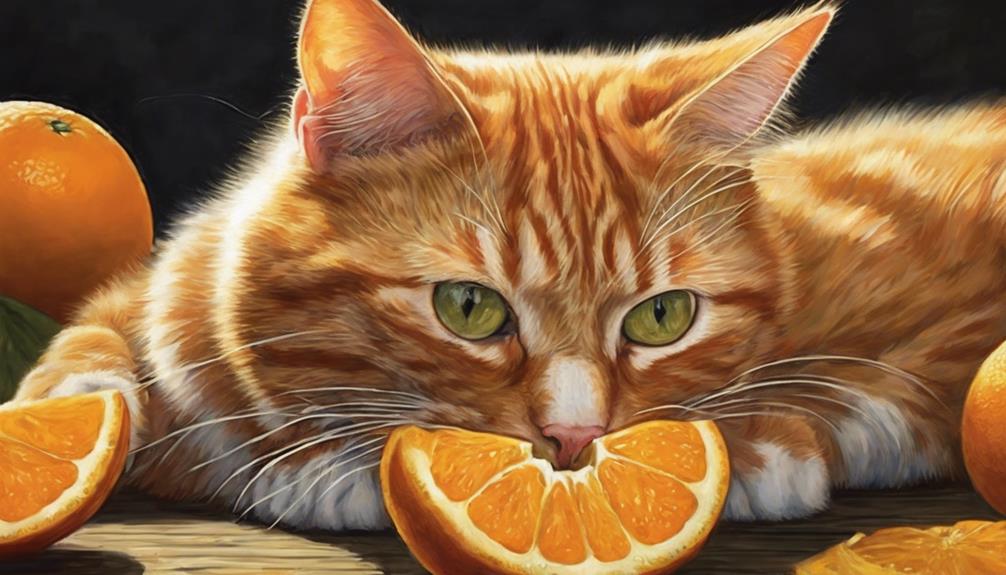
Oranges are harmful to cats. Essential oils, citric acid, psoralens, and furocoumarins in all parts of the fruit pose health risks for felines. Ingestion can cause vomiting, diarrhea, weakness, and more severe issues like neurological problems. Even the peel, seeds, and leaves are toxic. Cats may experience citrus sensitivity symptoms, making orange consumption dangerous. If your cat shows signs of citrus toxicity or ingestion, seek immediate veterinary care. Keeping oranges away from cats is vital to their well-being. To discover more about safe treats and dietary options, explore further.
Key Takeaways
- Oranges are toxic to cats due to harmful components like essential oils and citric acid.
- Ingesting oranges can cause vomiting, diarrhea, muscle tremors, weakness, and stomach upset in cats.
- All parts of an orange, including the peel, seeds, and leaves, are harmful to cats.
- Cats should not have oranges due to the risk of severe symptoms like neurological problems and allergic dermatitis.
- Immediate veterinary care is crucial if a cat ingests any part of an orange.
Oranges Are Toxic to Cats
Oranges pose a significant danger to cats due to their toxic components, which can cause various adverse reactions upon ingestion. Cats are curious creatures, and their exploration might lead them to oranges. However, it's important to understand that oranges and any citrus fruits contain substances that are toxic to our feline friends.
The essential oils, citric acid, psoralens, and furocoumarins found in oranges can wreak havoc on a cat's system if ingested. From the peel to the seeds and even the leaves, all parts of an orange can be harmful to cats. If a cat consumes oranges, they may experience unpleasant symptoms like vomiting, diarrhea, drooling, weakness, and even photosensitivity. These reactions can escalate to more severe issues such as neurological problems and allergic dermatitis.
To safeguard the well-being of our beloved cats, it's important to keep oranges and other citrus fruits far from their reach to prevent accidental ingestion and potential poisoning.
Harmful Components in Oranges

Oranges contain harmful components for cats.
Citrus oils are toxic and the high acidity causes issues, upsetting cats' stomachs.
It's crucial to keep oranges away from our feline friends to prevent any potential health problems.
Citrus Oils Are Toxic
After consuming citrus oils from oranges, cats may experience harmful effects on their nervous system. These oils contain compounds that can be toxic to our feline companions. To illustrate the dangers of citrus oils for cats, let's look at a comparison between the effects on humans versus cats:
| Effects | Humans | Cats |
|---|---|---|
| Ingestion | Generally safe | Toxic |
| Skin exposure | Mild irritation | Toxic |
| Aromatherapy | Therapeutic benefits | Toxic |
It's important to remember that what may be safe for us can be harmful to our furry friends. Hence, it's best to keep oranges and any citrus fruits away from cats to prevent any potential toxicity from citrus oils.
High Acidity Causes Issues
Essential acidity in oranges poses a risk to cats, leading to potential digestive issues and upset stomach due to their sensitivity to these harmful components. Cats' delicate digestive systems struggle to handle the acidity levels found in oranges, which can result in discomfort and health problems.
These acidic properties can irritate the stomach lining of cats, causing vomiting or diarrhea. Additionally, the high acidity in oranges may disrupt the natural pH balance in a cat's digestive tract, further exacerbating these issues.
It's essential to be cautious and avoid exposing your feline friends to foods like oranges that contain such high acidity levels, as it can have adverse effects on their well-being.
Upsets Cats Stomach
When cats ingest oranges, the important components present, such as citric acid and essential oils, can disrupt their stomach and lead to various digestive issues. These components can upset a cat's stomach, causing symptoms like vomiting, diarrhea, and stomach distress.
The sugar and acids in oranges may not sit well with your feline friend, potentially leading to discomfort and health issues. Essential oils found in oranges can even affect a cat's nervous system, compounding the problems.
It's vital to be mindful of what your cat consumes to avoid any unnecessary stomach upsets or adverse reactions. Keeping oranges away from your cat can help maintain their digestive health and overall well-being. Remember, a happy cat starts with a healthy stomach.
Citrus Sensitivity in Cats

When considering cats and citrus, it's crucial to be aware of the risks oranges pose to our feline friends. Oranges contain harmful compounds that can lead to symptoms like vomiting, diarrhea, and drooling in cats.
Knowing the signs of citrus toxicity and being cautious with citrus fruits around cats can help keep our pets safe and healthy.
Cats and Citrus
Noticing their strong aversion to citrus fruits, cat owners must be aware of the potential risks associated with cats and oranges due to their toxicity. Oranges contain essential oils, citric acid, psoralens, and furocoumarins, all of which can be harmful to our feline friends. Even the peels, seeds, and leaves of oranges pose a danger to cats, causing symptoms like vomiting, diarrhea, muscle tremors, weakness, and photosensitivity.
Cats instinctively avoid citrus fruits because of their intense smell and taste, acting as a natural defense mechanism. If a cat ingests any part of an orange, immediate veterinary attention is crucial to prevent severe health issues. Remember, keeping oranges away from your curious kitty is the best way to ensure their well-being.
Risks of Oranges
Given the essential toxicity of oranges to cats due to compounds like essential oils and citric acid, it's vital for cat owners to understand the risks associated with citrus sensitivity in felines. Oranges contain toxic compounds such as psoralens and furocoumarins, which can trigger adverse reactions in cats. These reactions may manifest as vomiting, diarrhea, muscle tremors, weakness, and stomach pain.
Surprisingly, orange peels, seeds, and leaves harbor higher levels of these harmful substances compared to the fruit itself, intensifying the danger for our feline friends. Additionally, cats can experience photosensitivity after ingesting oranges, making it crucial to prevent their access to citrus fruits.
Symptoms to Watch
Symptoms of citrus sensitivity in cats commonly manifest as stomach distress, vomiting, diarrhea, and drooling. When observing your feline friend for signs of citrus sensitivity, keep a close eye on the following symptoms:
- Lethargy: If your cat seems unusually tired or lacks energy, it could be a sign of citrus-related issues.
- Behavioral changes: Watch for any sudden shifts in your cat's behavior, such as increased irritability or withdrawal.
- Skin reactions: Check for any skin redness, itchiness, or swelling, as these could indicate an allergic reaction.
Monitoring your cat for these symptoms can help you catch any potential issues early on and seek prompt veterinary care if needed. Remember, your cat's well-being is always a top priority!
Symptoms of Citrus Toxicity
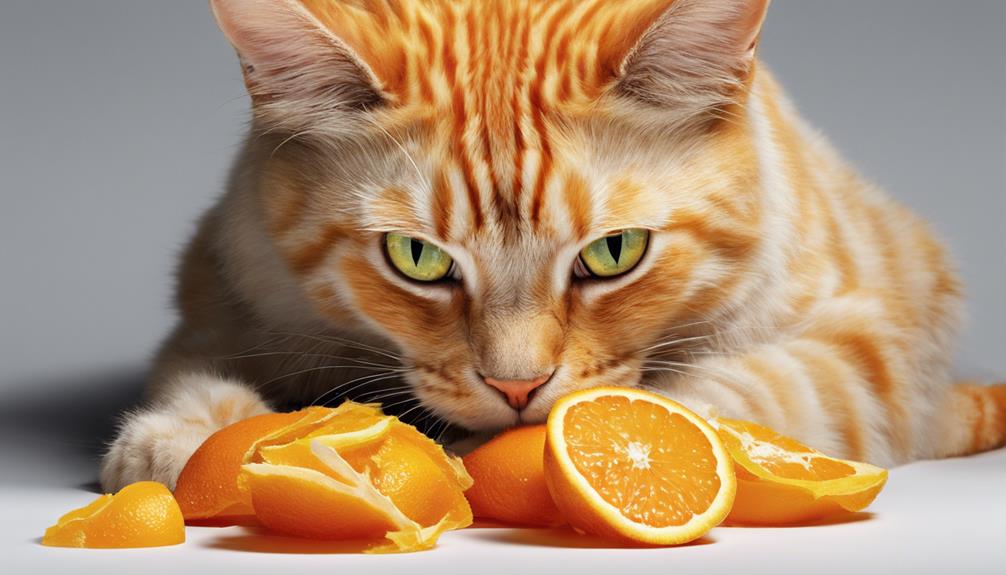
Experiencing stomach distress like vomiting and diarrhea is a common indicator of citrus toxicity in cats. If your feline friend starts drooling excessively or shows signs of weakness and depression after ingesting oranges, these could be symptoms of citrus poisoning.
In severe cases, citrus toxicity can even lead to nervous system issues in cats, making it imperative to monitor your pet's behavior closely if they've had any contact with citrus fruits. Another concerning symptom is photosensitivity, where cats become more sensitive to light after consuming oranges. This reaction indicates a potential toxicity that shouldn't be ignored.
If you notice any of these symptoms in your cat, veterinary care is necessary immediately. Remember, prevention is key, so keep oranges and other citrus fruits out of your cat's reach to avoid any potential health risks.
Repellent Nature of Oranges
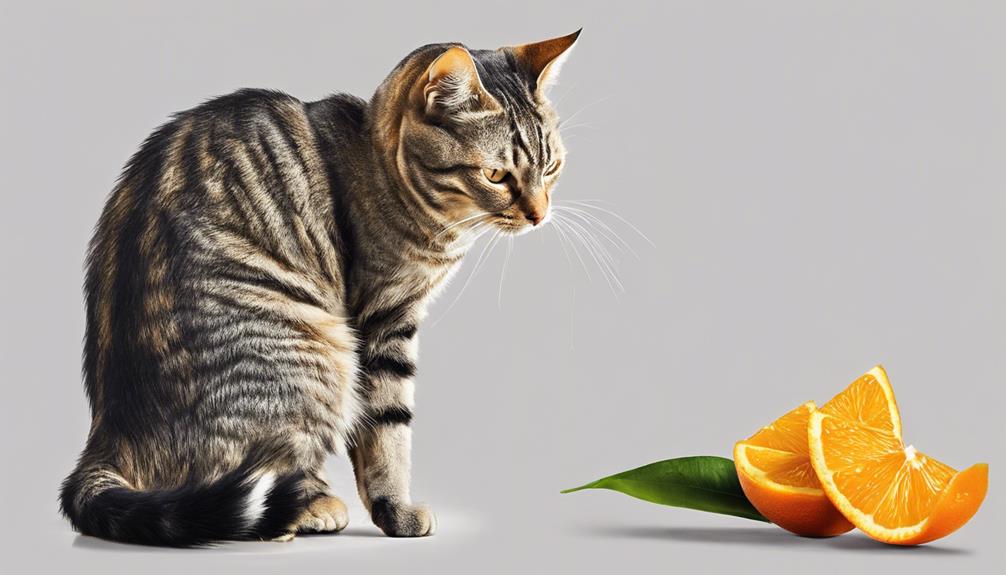
The natural repelling effect of oranges on most cats is due to their strong citrusy scent. Cats contain a highly sensitive sense of smell, and the intense aroma of citrus fruits like oranges can be overwhelming for them. This aversion to oranges is an instinctual response that helps protect cats from potential harm.
- Cats instinctively avoid citrus scents due to their sensitivity.
- Oranges emit a strong smell that cats find off-putting.
- The repellant nature of oranges for cats is a built-in protective mechanism.
Understanding why cats tend to steer clear of oranges can help pet owners ensure their feline friends stay safe and healthy. By recognizing and respecting cats' natural instincts to avoid citrus fruits, we can help prevent any unwanted incidents. It's crucial to provide a cat-friendly environment that aligns with their natural behaviors and preferences, including steering clear of foods like oranges that may not sit well with them.
Vomiting and Diarrhea in Cats
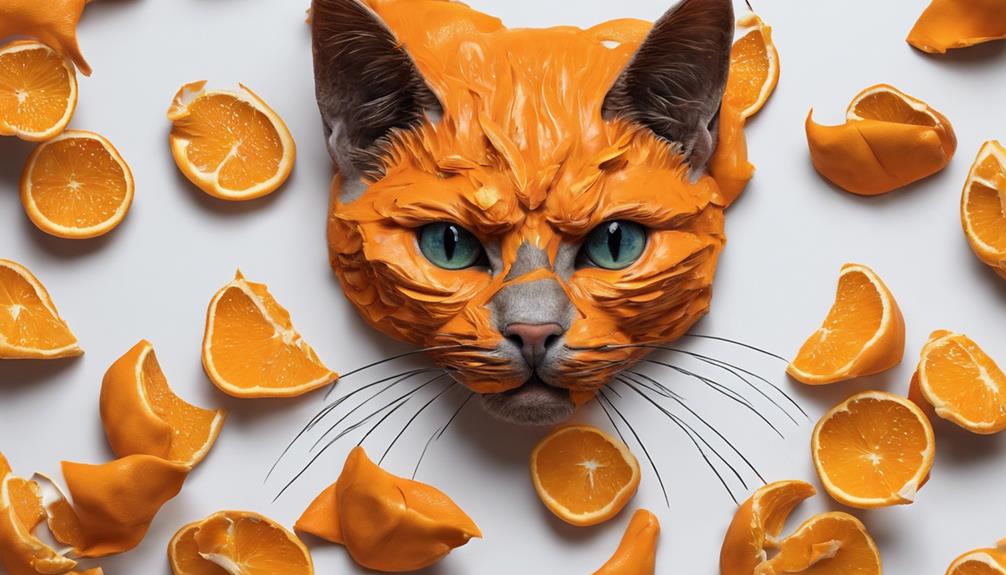
When cats ingest oranges, they may experience digestive issues such as vomiting and diarrhea.
The toxic components in oranges, like essential oils and acids, can irritate a cat's stomach, leading to these unpleasant symptoms.
If your cat shows signs of vomiting and diarrhea after consuming oranges, it's important to seek immediate veterinary care for proper management.
Digestive Issues in Cats
In some situations, cats can develop digestive issues, particularly vomiting and diarrhea, when exposed to oranges due to their high sugar and acidic content.
- Cats may show signs of stomach distress, including vomiting and diarrhea, if they consume oranges or citrus oils.
- Citrus poisoning from oranges can lead to gastrointestinal upset in cats, resulting in symptoms like vomiting and diarrhea.
- Orange peels, seeds, and leaves contain harmful compounds that can irritate a cat's digestive system, potentially causing vomiting and diarrhea.
If your feline friend experiences any digestive problems after ingesting oranges, it's important to seek veterinary care promptly for a proper diagnosis and appropriate treatment. Your cat's well-being is our top priority.
Causes of Vomiting
Experiencing vomiting and diarrhea in cats can stem from various factors, including dietary indiscretion, infections, parasites, or underlying health conditions. When our feline friends start vomiting, it can be a sign that something isn't quite right. To help you understand better, let's take a look at some common causes of vomiting in cats:
| Causes of Vomiting | Description |
|---|---|
| Dietary Indiscretion | Eating something they shouldn't |
| Infections | Viral or bacterial illnesses |
| Parasites | Worms or other infestations |
| Health Conditions | Kidney disease or pancreatitis |
These factors can lead to your cat feeling under the weather, so it's crucial to monitor their symptoms and seek veterinary advice if needed.
Managing Diarrhea in Cats
To effectively manage diarrhea in cats, it's important to closely monitor their symptoms and provide adequate hydration. When dealing with diarrhea in your feline friend, keep these tips in mind:
- Evaluate Their Diet: Check if recent changes in their cat food might be causing digestive upset.
- Offer Bland Food: Consider feeding your cat a bland diet like boiled chicken and rice to help soothe their stomach.
- Consult a Vet: If the diarrhea persists or is accompanied by other concerning symptoms, seek guidance from a veterinarian specializing in feline health.
Muscle Tremors in Cats
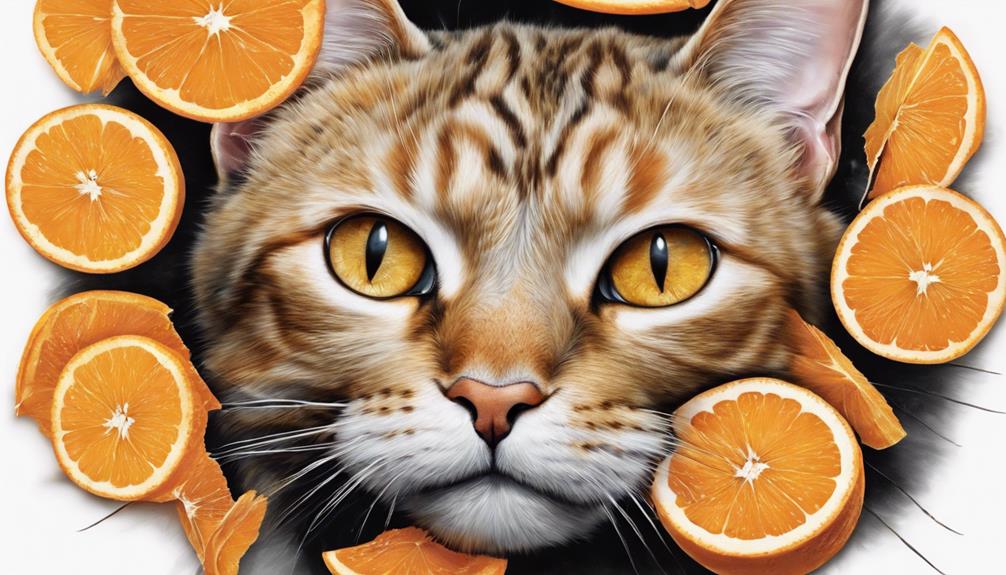
When cats display muscle tremors, it can be a clear indication of citrus toxicity resulting from consuming oranges. These involuntary muscle movements or shaking are signs of a serious toxic reaction that can stem from citrus poisoning. Cats may experience neurological issues, including muscle tremors, after ingesting oranges. It's critical to recognize that muscle tremors in cats indicate a harmful response to oranges and shouldn't be taken lightly.
If you notice your feline friend exhibiting muscle tremors, especially after consuming oranges, seeking immediate veterinary attention is imperative. Citrus toxicity can have severe consequences on your cat's health, and prompt intervention is necessary to address the situation effectively. Remember, muscle tremors are a red flag signaling potential citrus poisoning, and professional help is crucial in ensuring the well-being of your beloved pet. Keep a close eye on your cat's behavior and act promptly if you observe any concerning symptoms like muscle tremors.
Immediate Vet Contact Necessary
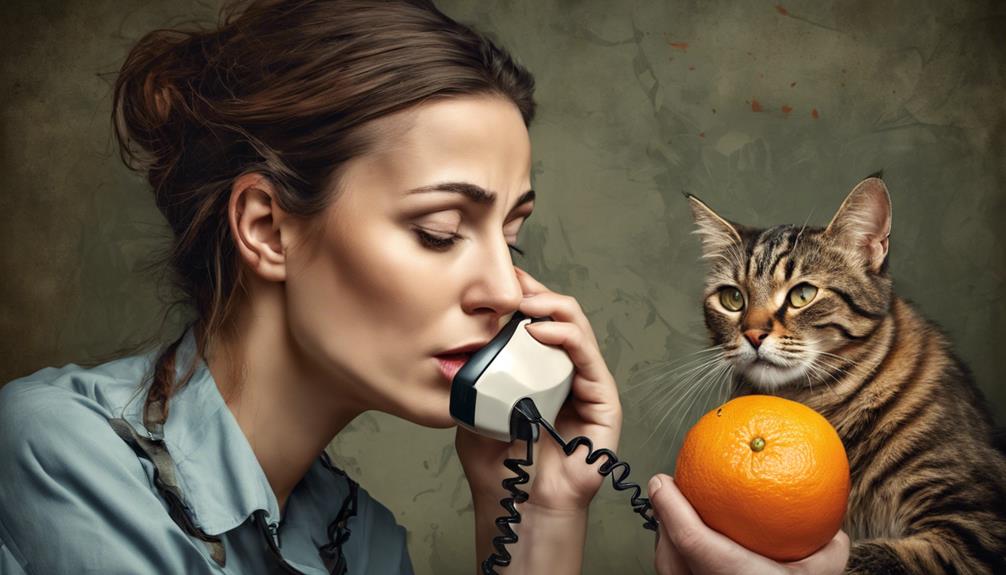
If your cat consumes oranges, immediate vet contact is essential as citrus can be toxic to felines. Symptoms to watch for include vomiting, diarrhea, weakness, and stomach pain.
Contact your veterinarian promptly if you notice any signs of citrus poisoning in your cat.
Cats and Citrus Sensitivity
Citrus sensitivity in cats can trigger severe symptoms like vomiting, diarrhea, and drooling, necessitating immediate veterinary attention. Cats are sensitive to essential oils and citric acid found in oranges, which can harm their digestive systems. When cats eat oranges, it can lead to weakness, stomach pain, and even photosensitivity.
Here are some important points to remember about cats and citrus sensitivity:
- Oranges can cause vomiting, diarrhea, and drooling in cats.
- Essential oils and citric acid in oranges may be harmful to cats' digestive systems.
- Immediate veterinary care is essential if a cat ingests oranges due to potential toxicity.
Signs of Toxicity
Recognizing the signs of citrus toxicity in cats is essential for prompt veterinary intervention. If your feline friend has ingested orange peel, watch for symptoms like vomiting, diarrhea, and drooling. Additionally, your cat may show signs of weakness, stomach pain, and increased sensitivity to light after consuming oranges. Immediate contact with your vet is critical if any of these indicators are present to guarantee your cat receives the necessary care. To help you recognize these symptoms better, here is a table outlining common signs of citrus toxicity in cats:
| Symptom | Description | Action |
|---|---|---|
| Vomiting | Expelling stomach contents | Contact vet immediately |
| Diarrhea | Loose or watery stool | Seek veterinary assistance |
| Drooling | Excessive saliva production | Immediate veterinary visit |
| Weakness | Lack of strength or energy | Urgent vet consultation |
Treatment Options
Upon suspecting citrus toxicity in cats, immediate veterinary contact is imperative for appropriate treatment options. When facing this situation, remember the following:
- Professional Evaluation: A veterinarian will assess the cat's condition and provide necessary treatment based on the severity of symptoms.
- Fluid Therapy: Intravenous fluids may be administered to help flush out the toxins and support the cat's hydration.
- Monitoring and Support: Continuous monitoring is essential to guarantee the cat's condition stabilizes, with additional supportive care as needed.
Avoiding Other Harmful Fruits
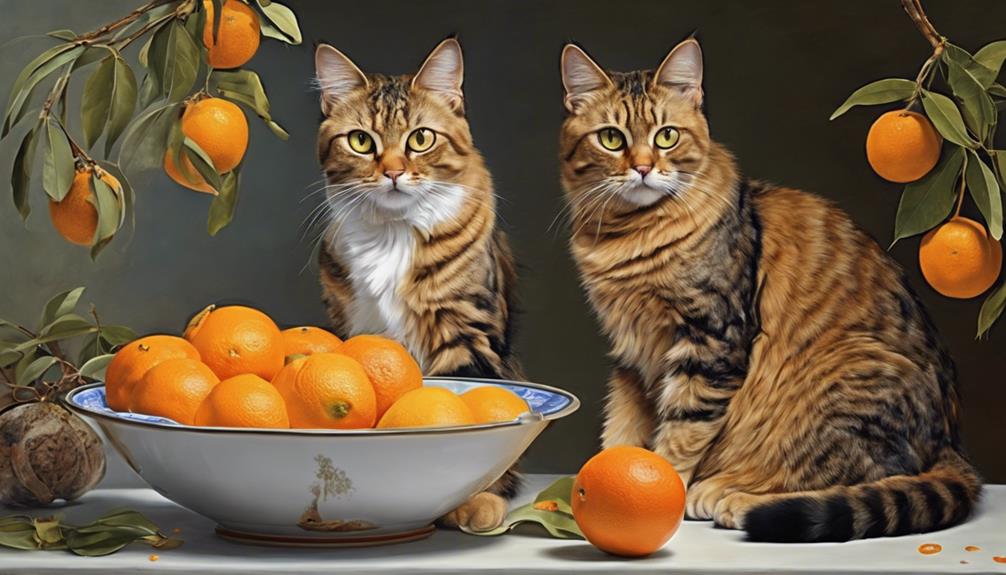
What other fruits should we avoid feeding to cats to prevent potential toxicity and health issues? Grapes, cherries, plums, and tomatoes are among the toxic fruits that can be harmful to our feline friends. These fruits have been linked to various health problems in cats, such as kidney failure, gastrointestinal upset, and respiratory issues.
Compounds like solanine in tomatoes and cyanide in cherries can pose serious risks to our cats' well-being. Even small amounts of grapes and raisins can lead to kidney failure in cats, making it imperative to steer clear of these fruits altogether.
To safeguard the safety and health of our beloved pets, it's crucial to be vigilant and avoid feeding them any fruits that could potentially be toxic. Researching and understanding which fruits are harmful to cats can help us make informed decisions when it comes to their diet, ultimately protecting them from unnecessary health risks.
Vitamins C and Cats

Discussing the importance of vitamin C for cats, it's essential to understand that they don't rely on oranges for this nutrient. Cats have the ability to produce their own vitamin C, so they don't need to consume it from fruits like oranges.
- Cats are self-sufficient: Unlike humans, cats can synthesize their own vitamin C, meeting their needs through their diet.
- Balanced diets: Providing cats with a well-rounded diet guarantees they receive all the essential nutrients they require, including vitamin C.
- Health considerations: While oranges are a good source of vitamin C for humans, they aren't necessary for feline health due to their unique ability to produce this vitamin internally.
Understanding your cat's nutritional requirements is critical for their well-being. By focusing on a complete and balanced diet designed for feline needs, you can make sure that your cat receives all the necessary vitamins, including vitamin C, without the need for oranges or other potentially harmful fruits.
Safety of Oranges for Cats

Oranges pose a significant risk to cats due to their toxic components like essential oils and citric acid. Pet parents, it's important to keep oranges away from your feline friends as all parts of the fruit, including peels, seeds, and leaves, can be harmful to them.
While cats typically avoid citrus fruits like oranges because of their strong scent, accidental ingestion can lead to symptoms such as vomiting, diarrhea, weakness, and even photosensitivity in our beloved pets.
If you suspect that your cat has ingested any part of an orange, immediate veterinary attention is necessary to prevent severe health issues. Remember, it's always better to be cautious than sorry when it comes to our furry companions' well-being.
Keep oranges out of reach and opt for cat-friendly treats to guarantee a happy and healthy life for your precious furball.
Signs of Orange Ingestion
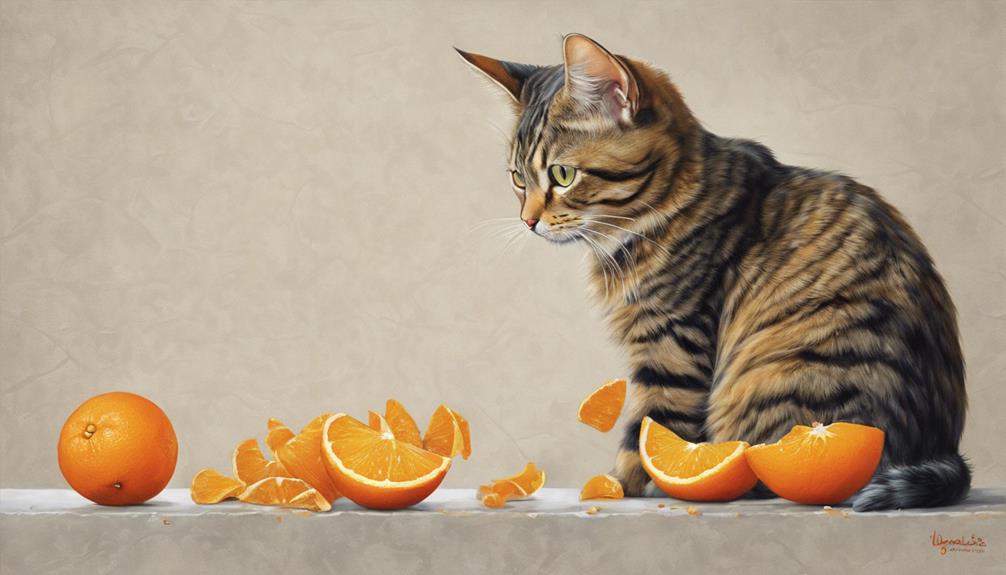
After highlighting the risks associated with oranges for cats, it's vital to recognize the signs of orange ingestion in feline companions. When a cat has eaten oranges, it's essential to be vigilant for any unusual behaviors or symptoms that may indicate they're experiencing issues due to this fruit.
Here are some signs to watch out for:
- Stomach Distress: Keep an eye out for any signs of stomach upset such as vomiting or diarrhea after your cat has eaten oranges.
- Weakness and Depression: If your feline friend seems unusually weak or depressed after consuming oranges, it could be a red flag.
- Excessive Drooling: Excessive drooling can be a sign of oral irritation or other problems that may arise from orange ingestion.
Opt for Healthier Cat Treats
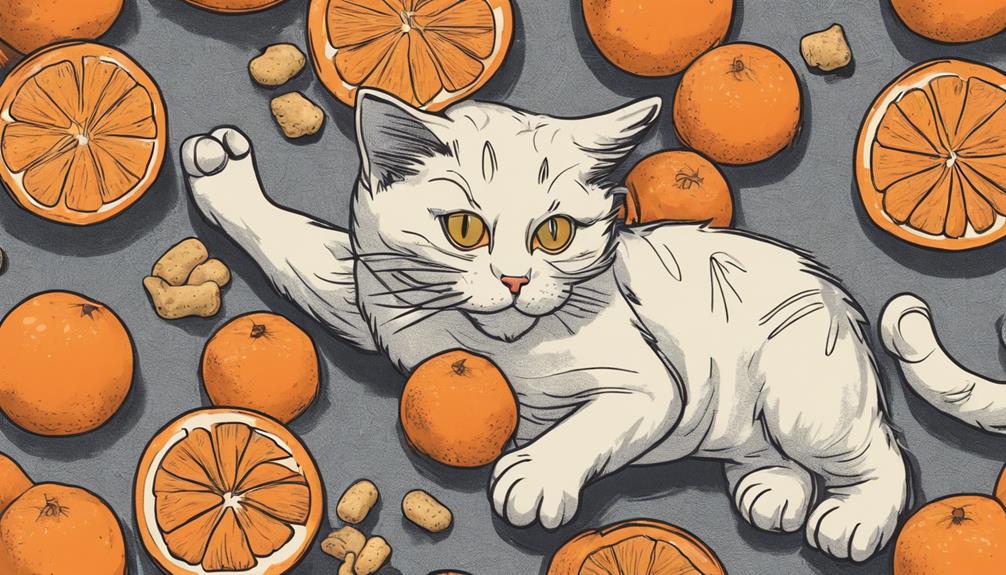
When selecting treats for your cat, prioritize options that guarantee their overall health and well-being. Opt for healthier cat treats that are specifically made for feline friends to make sure they're safe and nutritious. Safe fruit choices like blueberries, strawberries, bananas, apples, and melons can be excellent alternatives to traditional store-bought treats. Remember to remove any stems, leaves, cores, or seeds from fruits before offering them to your cat to prevent choking hazards.
It's essential to keep treats to only 10% of your cat's daily caloric intake to maintain a balanced diet and prevent weight issues. Before introducing new foods, especially to cats with health conditions like diabetes, consult with a veterinarian to guarantee it's safe and appropriate for your furry companion. By paying attention to the treats you offer your cat, you can contribute to their overall well-being and show them love through mindful pet care choices.
Consulting a Veterinarian

Seeking guidance from a veterinarian before introducing new foods to your cat's diet is vital for ensuring their well-being and safety. Vets can provide expert advice on whether cats can safely consume oranges. Consulting a veterinarian is essential as they can offer guidance on the potential risks and effects of oranges on a cat's health.
Additionally, a veterinarian can recommend safe alternatives to oranges for cat treats, ensuring that your feline friend enjoys tasty snacks without compromising their health. By seeking veterinary input, you're taking proactive steps to guarantee the well-being and safety of your beloved pet.
Citrus-Free Diet for Cats
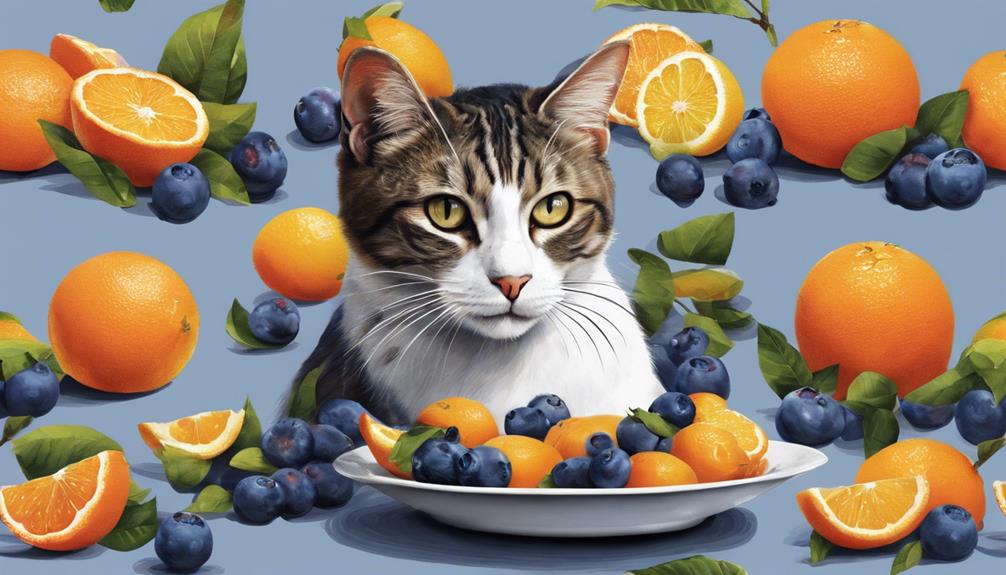
Before introducing any new foods to our cat's diet, it's essential to understand the importance of maintaining a citrus-free diet for their well-being. Oranges contain essential oils, citric acid, psoralens, and furocoumarins, all of which can be toxic to our feline friends. Even the peel, seeds, and leaves of oranges can be harmful if ingested by cats.
Symptoms of citrus toxicity may include vomiting, diarrhea, drooling, weakness, and photosensitivity. While most cats naturally avoid citrus fruits due to their strong smell and taste, it's vital to keep oranges out of reach to prevent accidental ingestion and potential poisoning.
Frequently Asked Questions
What Happens if My Cat Eats an Orange?
If my cat eats an orange, it can lead to stomach issues, vomiting, and more serious problems like nervous system issues or allergic reactions. The peel is especially dangerous. If symptoms arise, contacting a vet is essential.
Are Any Fruits Toxic to Cats?
Yes, some fruits are harmful to cats. It's important to avoid feeding cats toxic fruits like grapes, raisins, onions, garlic, and citrus fruits. These can lead to serious health issues and should be kept away from cats.
Is It Normal for a Cat to Like Oranges?
It's unusual for a cat to enjoy oranges. Their sensitive noses tend to dislike the citrus scent. While some cats might be curious, most will likely steer clear due to the strong smell.
Do Cats Like the Taste of Orange?
We, cats, generally dislike the taste of oranges due to their strong scent and bitter flavor. Our sensitive noses and natural instincts guide us away from citrus fruits. Oranges are not our preferred snack.
Is it Safe for Cats to Eat Fruits with High Water Content?
While cats eating melon safety guide may suggest that fruits with high water content are safe, it’s important to be cautious. Some fruits like melon can be consumed in moderation, but others like grapes and raisins can be toxic to cats. Always consult your vet before introducing new foods to your pet’s diet.
Conclusion
To wrap up, it's important to bear in mind that oranges are toxic to cats and should be avoided in their diet. Just a small amount of orange can cause harm to your feline friend. Remember, when it comes to treating your cat, opt for healthier options like cat-friendly treats.
Did you know that nearly 50% of cats may experience citrus sensitivity? It's always best to consult with your veterinarian to make sure your cat's diet is safe and healthy.
Paul’s love for animals knows no bounds. As a dedicated writer and animal lover, Paul brings a unique perspective to our team. His firsthand experiences with various animals enrich our content and provide valuable insights into their behavior and needs. Whether he’s sharing tips for pet care or shedding light on pressing conservation issues, Paul’s passion for animals shines through in everything he does.
Cats
How Do Cat Cafes Work?
Yearning to understand the inner workings of cat cafes? Discover the purrfect blend of feline fun and cozy ambiance in this intriguing exploration.
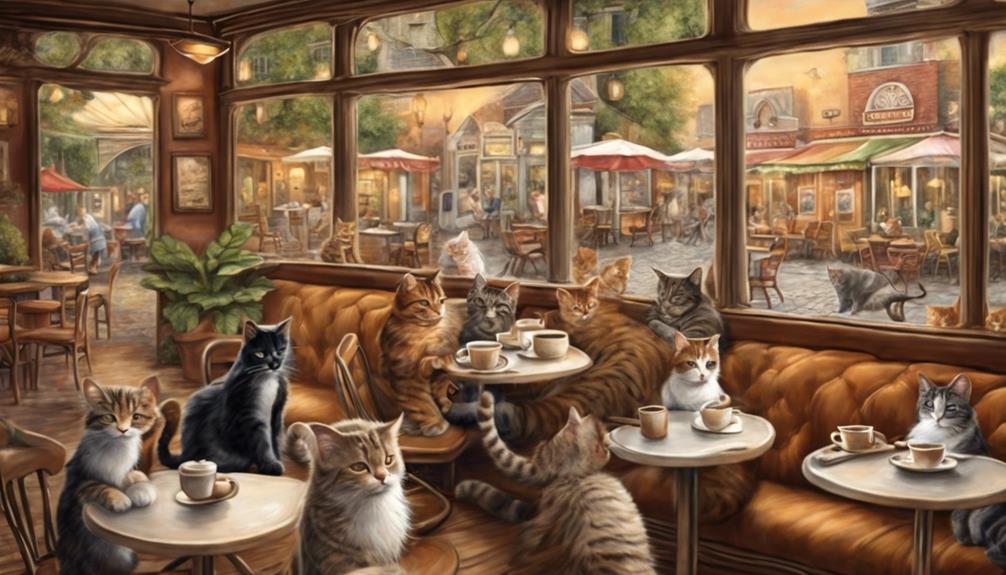
At cat cafes, we pay an hourly fee to hang out with resident cats. The entry cost is typically $9 to $10 per hour. We switch to comfy slippers and wash our hands before mingling with the cats. Activities include petting and feeding them. Food and drinks are prepped separately for hygiene. Reservations are a must due to limited space. Cat cafe etiquette involves no picking up cats and keeping noise down. Pricing covers maintaining a cozy environment. Safety and cleanliness are top priorities. Interested to know more about this unique experience?
Key Takeaways
- Patrons pay entry fees for hourly access to interact with resident cats.
- Reservations often required due to limited space and high demand.
- Guests follow specific hygiene protocols like hand-washing and shoe removal.
- Cat cafe staff ensure cat well-being, cleanliness, and visitor safety.
- Activities include petting, feeding, and playing with cats in designated areas.
Cat Cafe Basics
When visiting a cat cafe, patrons are charged an hourly fee to spend time with the resident cats. The entry fee typically ranges from $9 to $10 per hour, offering a cozy environment where visitors can relax and interact with the adorable feline residents. Upon arrival, guests are kindly asked to switch their shoes for comfy slippers and wash their hands thoroughly before mingling with the cats. This guarantees a clean and hygienic space for both the humans and the furry friends.
One of the highlights of cat cafes is the opportunity to engage in activities like petting and feeding the resident cats. These activities create a warm and inviting atmosphere, allowing visitors to bond with the cats and enjoy their company. Additionally, food and drinks are prepared in separate areas to maintain high hygiene and safety standards. This separation ensures that the cats remain healthy and happy, while visitors can enjoy their refreshments without any worries.
Reservation and Entry Procedures
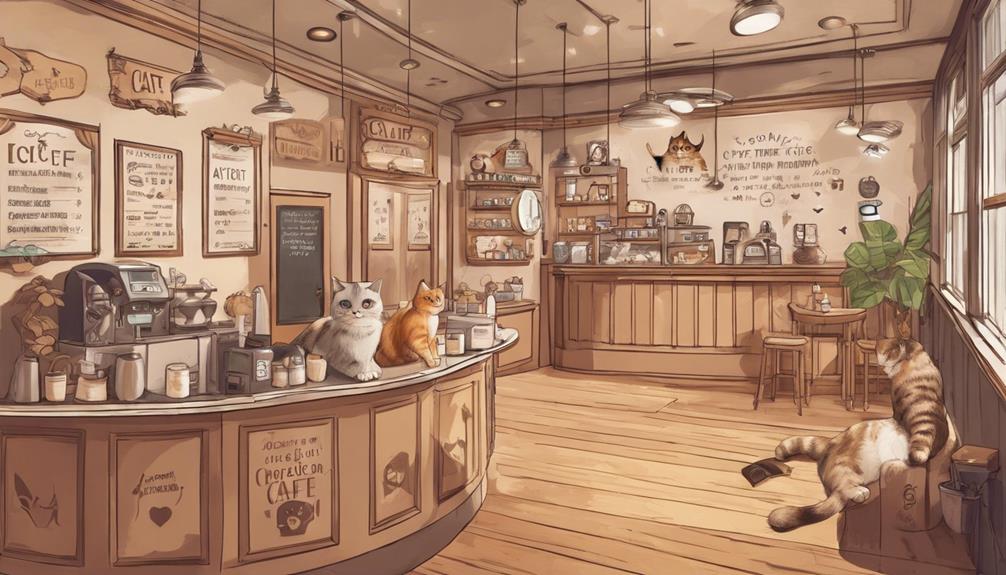
To guarantee a spot at a cat cafe, patrons typically need to make reservations in advance, as these establishments often have limited space and high demand. When making a reservation, some cat cafes may request an entry fee to cover the cost of maintaining a comfortable environment for both cats and visitors. These fees can vary depending on the location and the amenities offered. Additionally, entry procedures at cat cafes usually involve signing waivers to make certain that visitors understand and adhere to the rules for interacting with the cats.
Upon arrival, guests might encounter specific time slots for their visits to help manage the number of people in the cafe at any given time. To uphold hygiene standards, visitors may be required to remove their shoes and wear provided slippers before entering the cat area. Some cafes even have hand-washing stations available to ensure that everyone cleans their hands before engaging with the feline residents. These measures contribute to a safe and enjoyable experience for both visitors and the cats.
Interacting With the Cats
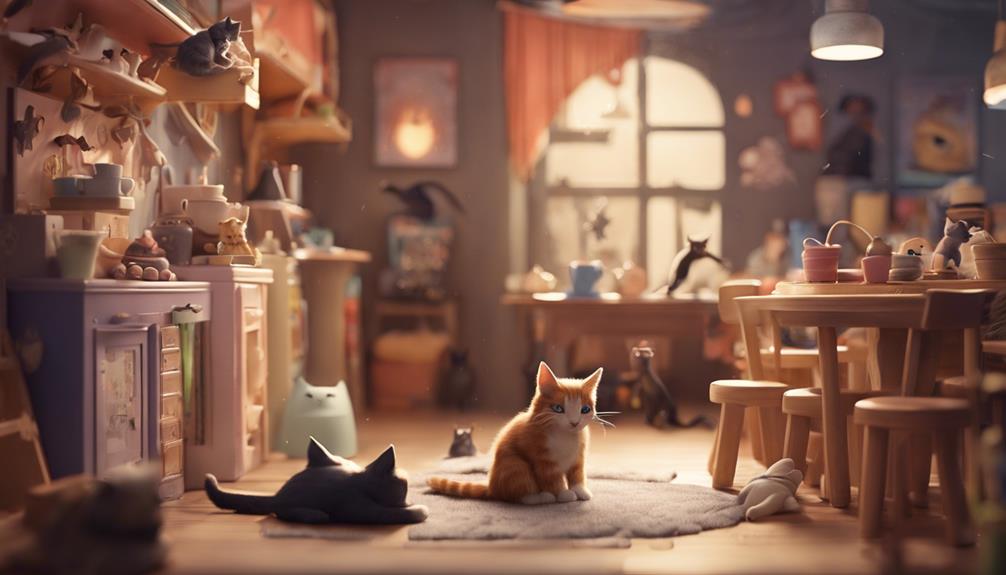
When visiting a cat cafe, it's important to follow cat cafe etiquette to guarantee a pleasant experience for both the cats and the guests.
Playtime with the felines can involve interactive toys, gentle petting, and respecting their boundaries.
Cat Cafe Etiquette
Maintaining a demeanor of respect towards the feline residents at a cat cafe involves adhering to specific guidelines for interacting with them gracefully and considerately.
- Avoid picking up the cats: Respect their space and let them come to you.
- Keep noise levels low: Cats appreciate a calm environment for relaxation.
- Refrain from flash photography: Prevent startling or distressing the cats with sudden bright lights.
- Eat and drink in designated areas: Maintaining hygiene standards and preventing disruptions for the cats is essential.
Playtime With Felines
Respecting the feline residents' boundaries, we can now explore engaging in playtime with the cats at cat cafes. Visitors have the opportunity to interact with the felines through petting, cuddling, and interactive toys, creating a relaxing and enjoyable atmosphere.
These interactive sessions not only entertain guests but also allow for social interaction and stress relief. Each cat has its own unique personality, with some being more playful while others prefer a calmer interaction. Engaging in playtime with the cats can be therapeutic, reducing anxiety and improving mood.
Observing and bonding with the resident felines can bring joy and comfort, making the experience at cat cafes truly special. So, grab a toy and indulge in some quality playtime with these adorable companions!
Food and Beverage Guidelines

Cat cafes guarantee strict adherence to separate food and beverage preparation areas to uphold hygiene standards while allowing visitors to bring drinks into designated cat zones under specific guidelines.
When it comes to enjoying your time with the feline residents, here are some important food and beverage guidelines to keep in mind:
- Separate Preparation Areas: Food and drinks are prepared away from where the cats roam to maintain hygiene standards.
- Visitor Guidelines: Visitors can bring beverages into designated cat areas, but following the specific guidelines set by the cafe is crucial.
- Regulations: Some cities have rules prohibiting cats from areas where food and drinks are served to prioritize health and safety.
- Cleanliness Requirements: Patrons must uphold cleanliness by washing hands and switching to slippers before interacting with the cats to ensure a safe and pleasant experience for everyone involved.
Pricing and Time Allocation
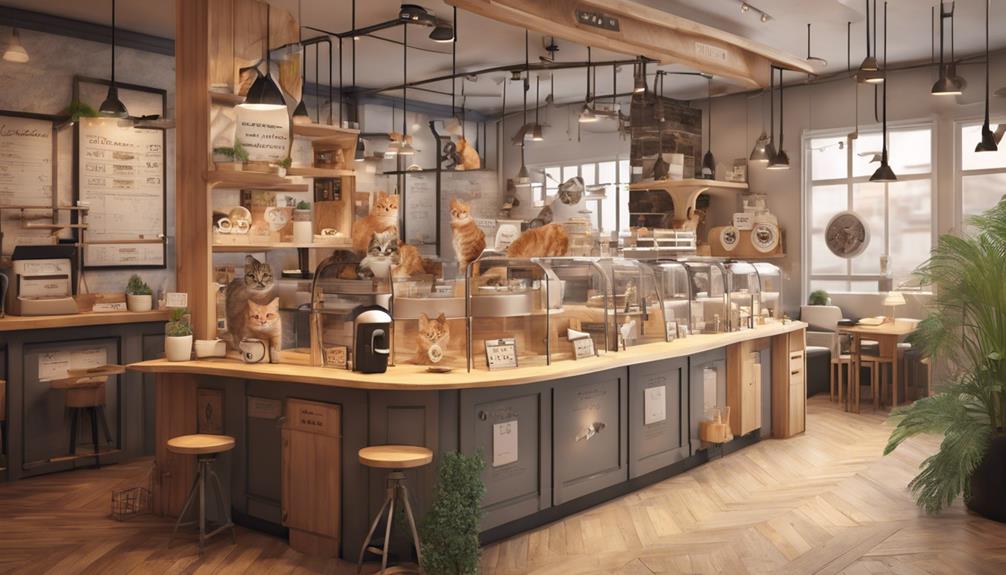
As we explore the pricing and time allocation at cat cafes, visitors typically pay around $9-$10 per hour to enjoy the company of resident cats in a relaxed environment. The pricing structure at cat cafes is designed to offer patrons a set period of time where they can unwind and interact with the feline residents. This hourly fee covers the cost of maintaining and caring for the cats, ensuring their well-being and comfort while providing visitors with a unique and cozy experience.
| Cat Cafes | Pricing Structure | Hourly Fee |
|---|---|---|
| Enjoy the company of resident cats | Set period of time for relaxation | $9-$10 per hour |
Safety Measures for Guests

Upon entering a cat cafe, guests are required to trade their shoes for slippers and wash their hands before interacting with the feline residents. Ensuring a safe and enjoyable experience for everyone is paramount, and the cafe implements several safety measures to maintain a clean environment.
- Hygiene Measures: The cafe enforces strict hygiene practices to separate food and drinks from the cat area, minimizing any contamination risks.
- Safety Measures: Precautions are in place to mitigate potential health hazards associated with interacting with the cats, prioritizing the well-being of both guests and resident felines.
- Food and Drinks: Beverages are allowed in the designated cat area, allowing patrons to enjoy their drinks while spending time with the adorable cats.
- Regulatory Compliance: Some cities have regulations against cats and food sharing the same space, prompting cat cafes to adhere to specific guidelines to uphold cleanliness standards.
Cat Health and Well-being
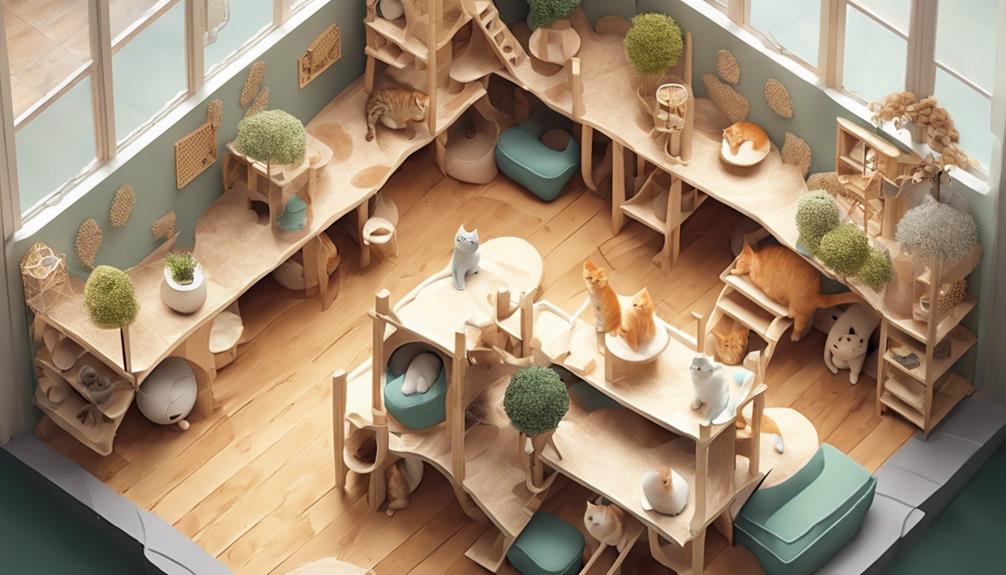
Prioritizing the overall welfare of our feline residents, we guarantee their health and well-being through regular veterinary care and dedicated spaces for rest and play. Cat health is a top priority in our cat cafes, with routine vet check-ups and vaccinations to make certain our furry friends are happy and healthy. Our cat lounges are thoughtfully designed with areas for relaxation, feeding, and play to maintain their well-being. These spaces are equipped with toys and scratching posts to keep the cats mentally and physically stimulated, promoting their overall health.
We acknowledge the importance of creating a safe environment that prioritizes the health and comfort of our feline residents. Our trained staff carefully monitor cat behavior and promptly address any health concerns that may arise, ensuring that our cats receive the best care possible. With these measures in place, our cat cafes aim to provide a nurturing and enriching environment for both our cats and visitors.
Staff Roles and Responsibilities
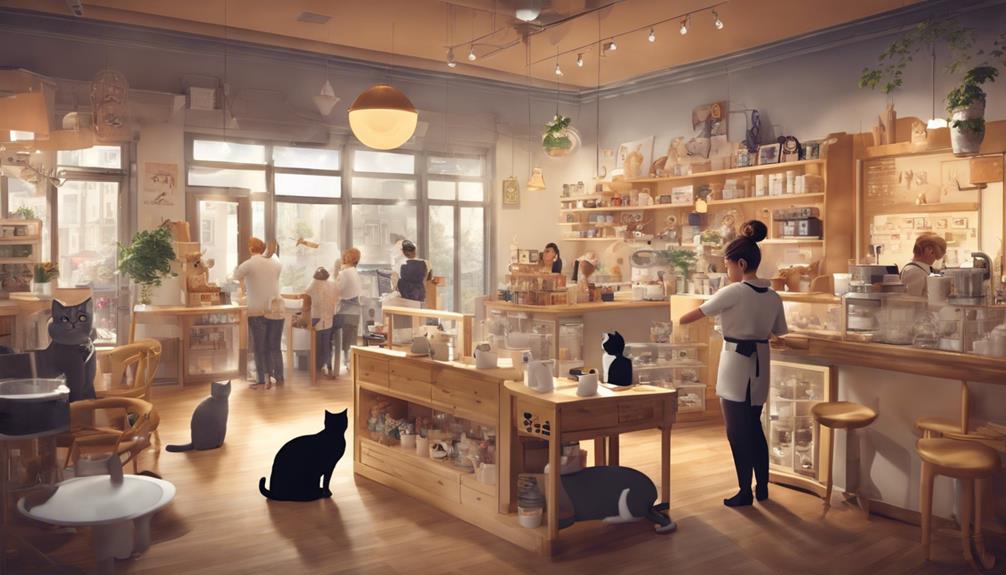
In managing a cat cafe, our team of dedicated staff members plays a pivotal role in ensuring the well-being and care of our resident felines. Our responsibilities encompass various tasks that aim to maintain a safe and comfortable environment for both the cats and our visitors.
Here are some key aspects of our staff roles:
- Feeding and Hydration: We make sure that our furry friends have access to fresh food and water at all times.
- Cleaning and Monitoring: Regular cleaning and health monitoring are vital for the well-being of our resident cats.
- Visitor Engagement: We love sharing information about our cats and facilitating interactions between them and our visitors.
- Hygiene Standards: Maintaining high hygiene standards in the cat lounge and food areas is a top priority to guarantee a clean and safe environment for everyone.
Our team aims to create a welcoming atmosphere where cats can thrive and visitors can enjoy their time in our cat cafe.
Hygiene Practices in Cat Areas
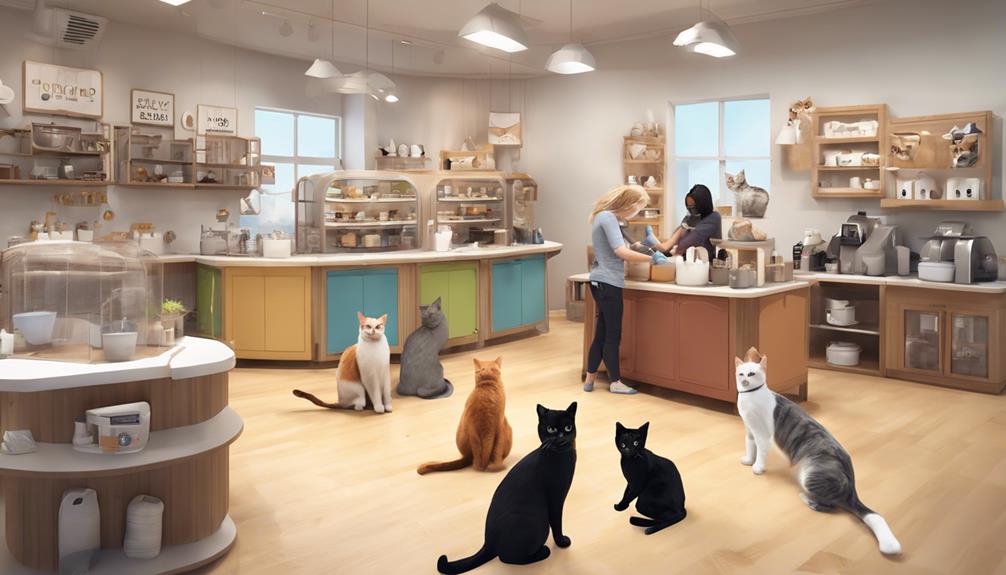
Maintaining a high level of cleanliness in cat areas is essential for the health and well-being of both the felines and visitors. This includes regularly cleaning cat furniture, disinfecting cat toys, and closely monitoring litter boxes.
Cleaning Cat Furniture
Regularly cleaning cat furniture and play areas at cat cafes is crucial for maintaining a clean and healthy environment for both the resident cats and visitors. To guarantee excellent hygiene, we adhere to strict cleaning schedules and use pet-friendly cleaning products. Keeping cat furniture sanitized not only prevents the spread of diseases among our furry friends but also creates a welcoming space for everyone to enjoy.
Here are some key points to emphasize our dedication to cleanliness:
- Following stringent cleaning schedules
- Using pet-friendly cleaning products
- Preventing the spread of diseases among resident cats
- Providing a clean and healthy environment for cats and visitors
Disinfecting Cat Toys
Guaranteeing the cleanliness of cat toys is a vital aspect of upholding hygiene in cat areas at our cafe. To safeguard our furry friends and visitors, we adhere to strict protocols for disinfecting cat toys regularly. This practice not only prevents the spread of germs and diseases but also establishes a safe environment for everyone. Our dedication to proper hygiene practices includes thorough cleaning and sanitizing of all cat toys. By prioritizing the well-being of the cats, we ensure a healthy and happy space for all. Below is a table outlining our toy disinfection process:
| Hygiene Practices for Cat Toys | Frequency | Products Used |
|---|---|---|
| Disinfect cat toys | Daily | Pet-safe cleaner |
| Rotate toys | Weekly | Vinegar solution |
| Inspect for damage | Bi-weekly | Natural disinfectant spray |
Monitoring Litter Box
We carefully monitor the cleanliness of litter boxes multiple times a day to maintain hygiene standards in the cat areas at our cafe.
- Regular scooping and cleaning keep the environment fresh.
- Proper waste disposal prevents odors.
- Staff follow strict protocols for handling waste.
- Hygiene practices guarantee the well-being of our feline friends.
Cat Cafe Layout and Design

Cat cafes strategically plan their layout and design to create a comfortable and stimulating environment for both cats and visitors. The design of these cafes takes into account the natural behaviors of cats, guaranteeing there are spaces for hiding, exploring, and climbing. To maintain hygiene, cats are kept separate from food preparation areas, adhering to health regulations. Visitors can enjoy their drinks in the cat lounge after purchasing them from the café, enhancing the overall experience.
| Cat Cafe Layout | Features | Purpose |
|---|---|---|
| Designated Areas | Café and Cat Lounge | Comply with regulations |
| Condos for Cats | Acclimation and Security | Ensure cat comfort |
| Stimulating Spaces | Hiding and Exploration | Cater to cat behaviors |
This layout and design aim to create a harmonious environment where cats can feel at ease, and visitors can enjoy the company of these feline companions in a clean and inviting setting.
Entertainment and Enrichment Activities

Cat cafes offer a range of entertainment and enrichment activities to keep the resident cats engaged and happy. These include:
- Playtime with toys
- Interactive sessions like grooming
- Clicker training to stimulate the cats mentally and physically
Providing such activities not only prevents boredom but also encourages socialization among the feline inhabitants.
Cat Toys
Selecting a variety of engaging toys is vital in guaranteeing the well-being and mental stimulation of our feline residents at the cat cafe. Our resident cats enjoy a range of toys that cater to their different play styles and preferences. Here are some key points about the cat toys in our cafe:
- Feather wands provide interactive fun for cats to pounce and chase.
- Interactive puzzles challenge cats mentally, keeping them engaged.
- Scratching posts help cats fulfill their natural urge to scratch and stretch.
- Toys are rotated regularly to prevent boredom and ensure continuous entertainment.
These toys not only entertain our cats but also promote their physical and mental health, making their stay at the cafe enriching and enjoyable.
Interactive Play
Rotating a variety of engaging toys and activities promotes the mental and physical well-being of our feline residents at the cat cafe, with interactive play being a key component of their enrichment. Cat cafes provide a stimulating environment with toys, tunnels, and climbing structures to keep our furry friends entertained and active.
Enrichment activities like puzzle feeders and interactive games are vital to keep their minds sharp and engaged. Through interactive play, cats not only exercise but also socialize with visitors, creating a dynamic and enriching experience for both the cats and guests.
Scheduled playtime sessions guarantee that all cats receive the mental and physical stimulation they need to stay happy and healthy while awaiting their forever homes.
Adoption Process for Cats
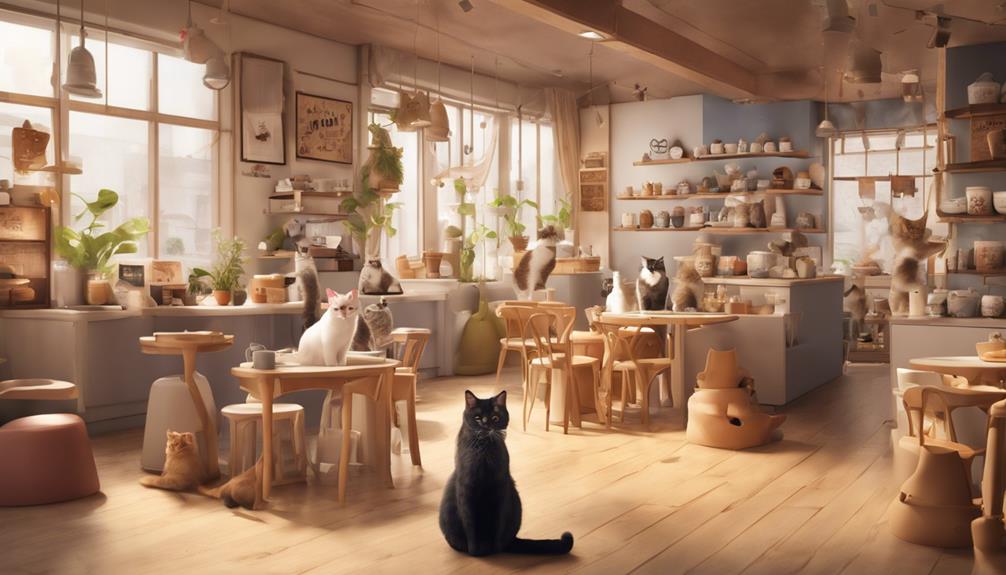
Partnering with local shelters, cat cafes showcase available cats for adoption, facilitating the process through interactive experiences for visitors. When you're ready to adopt a furry friend, here's what you can expect at a cat cafe:
- Interactive Play: Visitors can engage with the cats, helping them socialize and become more comfortable around humans.
- Adoption Applications: The process is streamlined through the partnering shelters or rescue groups, making it easy for you to apply.
- Health Checks: Cats at the cafe are spayed/neutered, vaccinated, and vetted to guarantee they're healthy and ready for their forever homes.
- Space Relief: By adopting from cat cafes, you're not only gaining a new companion but also helping free up space at shelters for other cats in need.
The adoption process at cat cafes is designed to create successful placements and find loving homes for these wonderful feline friends.
Customer Feedback and Reviews
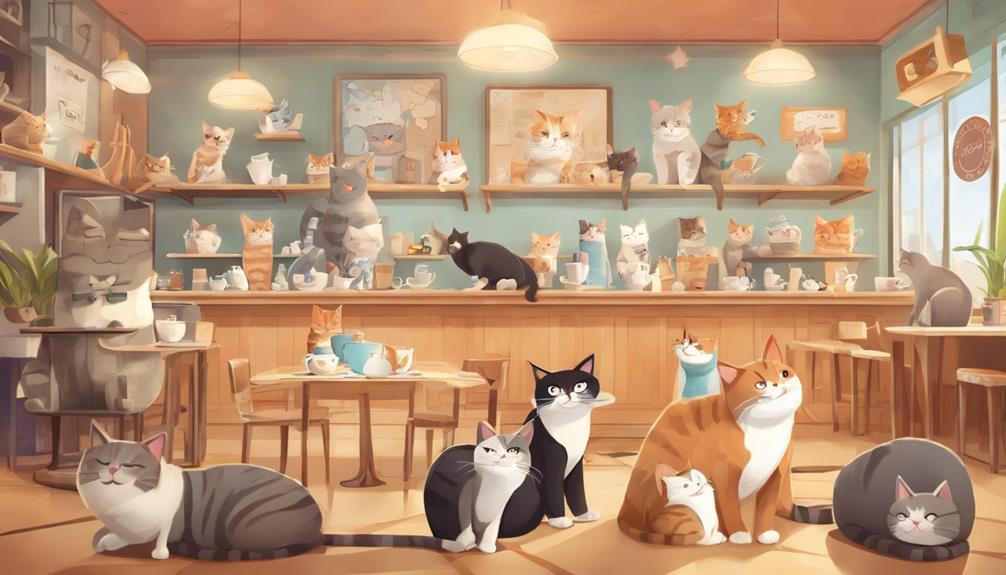
When examining customer feedback and reviews for cat cafes, it's vital to assess the effectiveness of the rating system, typical grievances, and the overall impact on business.
Ratings play a pivotal role in guiding potential customers, while complaints can offer insight into areas requiring enhancement.
Understanding how feedback influences the success of cat cafes is imperative for their ongoing development and customer satisfaction.
Rating System Effectiveness
Customer feedback and reviews are pivotal in evaluating the effectiveness of a cat cafe's rating system. When it comes to understanding how well a cat cafe is doing, these insights are pure gold. Here are a few key points to take into account:
- Ratings serve as a mirror of visitors' experiences with the cats, ambiance, and service.
- Positive reviews can attract more cat enthusiasts through the doors and elevate the cafe's reputation.
- Negative feedback sheds light on areas needing improvement that could influence future visits.
- Monitoring and addressing reviews promptly can help cat cafes maintain high ratings and enhance overall customer satisfaction.
Common Customer Complaints
Upon reviewing customer feedback and reviews, it becomes evident that common complaints at cat cafes often center around cleanliness, cat behavior, seating arrangements, menu options, and customer service. Customers frequently express concerns about the hygiene standards and cleanliness of the cafe, impacting their overall experience.
Some visitors are disappointed by the behavior of the cats, finding them unfriendly or uninterested in interacting. Issues with the layout and seating arrangements, such as a lack of designated cat-free areas, also contribute to negative feedback.
Additionally, slow service, limited menu choices, and high prices can detract from the enjoyment of the cat cafe experience. Inconsistent or inadequate customer service, including staff attitude and responsiveness, further exacerbates these grievances.
Impact on Business
Monitoring and responding to feedback from patrons is essential for cat cafes to gauge their impact on business operations and maintain a positive reputation. Customer feedback and reviews are invaluable tools for understanding what customers appreciate and where improvements can be made. Positive reviews can attract more visitors and increase the cafe's popularity. Reviews that highlight positive experiences with the cats can also encourage adoptions and support for the cafe's mission. By actively engaging with customer feedback, cat cafes can continuously enhance their offerings and create a loyal customer base.
- Customer feedback guides improvements
- Positive reviews attract more visitors
- Reviews encourage cat adoptions
- Engagement fosters customer loyalty
Marketing and Promotion Strategies
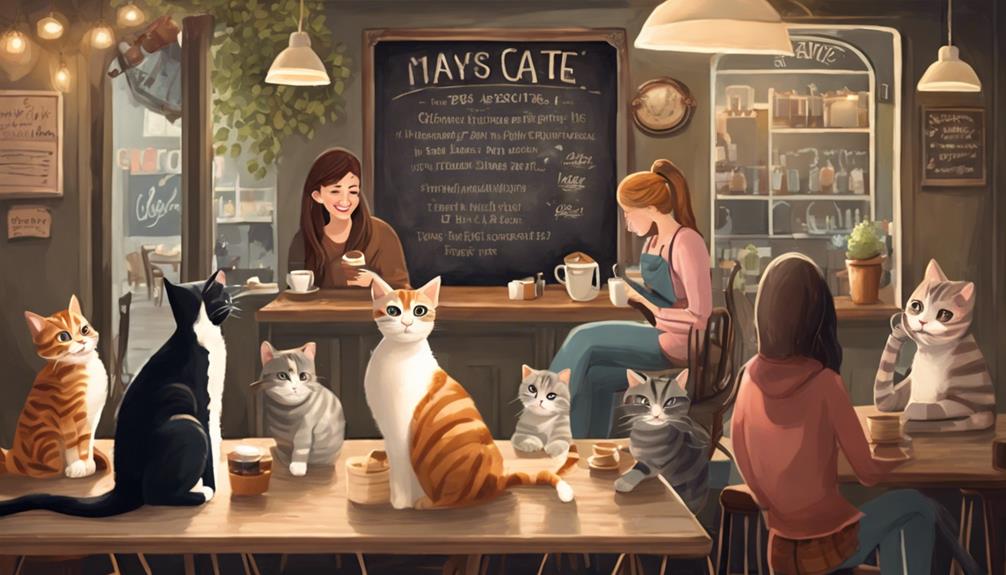
Utilizing social media platforms and collaborating with local influencers are key strategies cat cafes employ to promote their events and attract a wider audience. By sharing adorable pictures of our feline residents on Instagram and Facebook, we create a buzz that draws in cat lovers from all around.
Partnering with influencers and bloggers in the community helps us expand our reach and connect with new customers who mightn't have heard of us otherwise. Themed events like 'Meowga' and movie nights add a unique twist, making visits to the cafe not just about coffee but also about memorable experiences with our whiskered friends.
Offering special promotions during quieter times keeps our regulars coming back for more cuddles and purrs. Collaborating with local businesses for exclusive deals or cat-themed merchandise creates a win-win situation, driving traffic to both establishments. It's all about creating a purrfect blend of online promotion and real-world connections to make our cat cafe a beloved spot for all.
Future Trends in Cat Cafe Industry

As cat cafes continue to evolve and attract a growing customer base, future trends in the industry are poised to shape the way these establishments interact with their feline residents and customers.
- Incorporating Technology: Imagine interactive experiences where you can play with cats through virtual reality or control robotic toys remotely.
- Specialized Themes: Picture cat cafes dedicated to specific breeds or whimsical themes like sci-fi or fairy tales, providing a unique environment for cat lovers.
- Sustainability Practices: Expect a shift towards eco-friendly operations, such as using biodegradable products and implementing energy-saving measures to create a greener space.
- Community Engagement: Anticipate more collaborations with local animal welfare organizations for adoption events, fundraisers, and educational programs, fostering a sense of community and social responsibility within the cat cafe industry.
These trends promise to enhance the overall cat cafe experience, offering a blend of technology, creativity, sustainability, and community involvement for both cats and humans to enjoy.
Frequently Asked Questions
What Happens to Cats in a Cat Cafe on a Night?
At night, we make sure cats in our cafe are safe and rested. They have a separate cozy area with toys and amenities. Our staff monitors them, prioritizing their comfort and promoting relaxation.
Do You Bring Your Cat to a Cat Cafe?
No, we don't bring our cat to a cat cafe. We enjoy interacting with the resident cats there. It's a relaxing experience without the worry of looking after our own pet. The cafe guarantees a stress-free environment for the cats.
Do Cat Cafes Treat Cats Well?
We absolutely prioritize the well-being of our feline residents. They are treated with respect and care, ensuring a safe and comfortable environment. Regular monitoring and socialization activities guarantee their happiness. Our furry friends are family.
How Long Can You Spend in the Cat Cafe?
We can typically spend between 30 minutes to an hour in a cat cafe. Some places may have a max time per session. Entry fees usually cover a set time slot for us to enjoy the feline company.
Conclusion
To sum up, cat cafes offer a unique experience for cat lovers to enjoy the company of feline friends while sipping on a cup of coffee.
One interesting statistic to note is that the first cat cafe opened in Taiwan in 1998 and has since spread to countries around the world, including Japan, the United States, and Europe.
The popularity of cat cafes continues to grow, providing a relaxing and enjoyable environment for both cats and humans alike.
Paul’s love for animals knows no bounds. As a dedicated writer and animal lover, Paul brings a unique perspective to our team. His firsthand experiences with various animals enrich our content and provide valuable insights into their behavior and needs. Whether he’s sharing tips for pet care or shedding light on pressing conservation issues, Paul’s passion for animals shines through in everything he does.
Cats
Cat Sleeping Positions Near Their Owner: 3 Adorable Styles
Huddle up with your feline friend to uncover the heartwarming secrets behind their adorable sleeping positions near you.
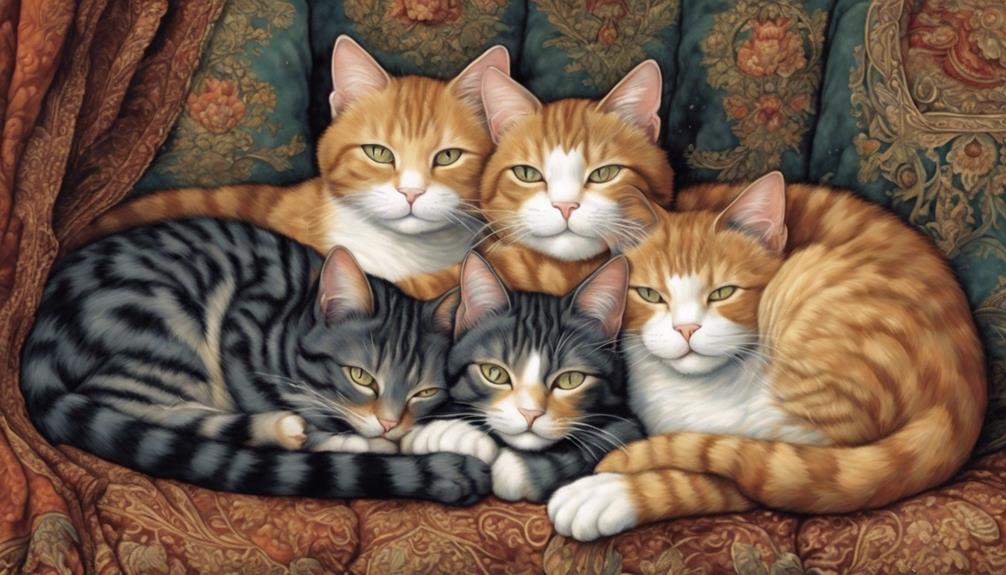
When a cat snuggles on your lap, it brings warmth, comfort, and a soothing heartbeat, fostering a strong bond. Curled up at your feet, they seek closeness, security, and show affection. Snuggling by your side, they stay warm, feel protected, and showcase trust and desire for closeness. These adorable sleeping positions near owners are not only cute but also demonstrate the deep emotional connection between cats and humans. So, next time your feline friend sleeps near you, cherish these sweet moments. Each position reveals a unique aspect of your cat's feelings towards you.
Key Takeaways
- Cozy cuddle on the lap provides warmth, comfort, and strengthens the emotional bond between cats and their owners.
- Curled up at the feet shows desire for closeness, offers security, and builds a strong bond of companionship.
- Snuggling by the side signifies trust, affection, and creates a strong emotional connection between cats and humans.
- Cat sleeping positions demonstrate love, trust, and the desire for closeness, strengthening the unique bond between cats and their owners.
- These adorable styles of cat sleeping positions provide warmth, comfort, reduce stress, and strengthen the emotional bond with their owners.
Cozy Cuddle on the Lap
When cats feel cozy, they often choose to cuddle on their owner's lap for warmth and comfort. This close bond allows for moments of affection and relaxation. As a cat nuzzles into their owner's lap, the soothing warmth and steady heartbeat can create a sense of security and calm. Lap cuddles not only provide physical warmth but also emotional comfort, strengthening the bond between the cat and their human companion. The act of snuggling on their owner's lap can be a gesture of trust and love, showcasing the deep connection between the two.
Moreover, these cozy lap cuddles have been shown to reduce stress and anxiety in cats. The sense of security and familiarity that comes from resting on their owner's lap can help alleviate any tension or worries the cat may be experiencing. It's a mutually beneficial arrangement – the cat finds solace and warmth, while the owner gets to enjoy the affectionate company of their feline friend.
Curled Up at the Feet
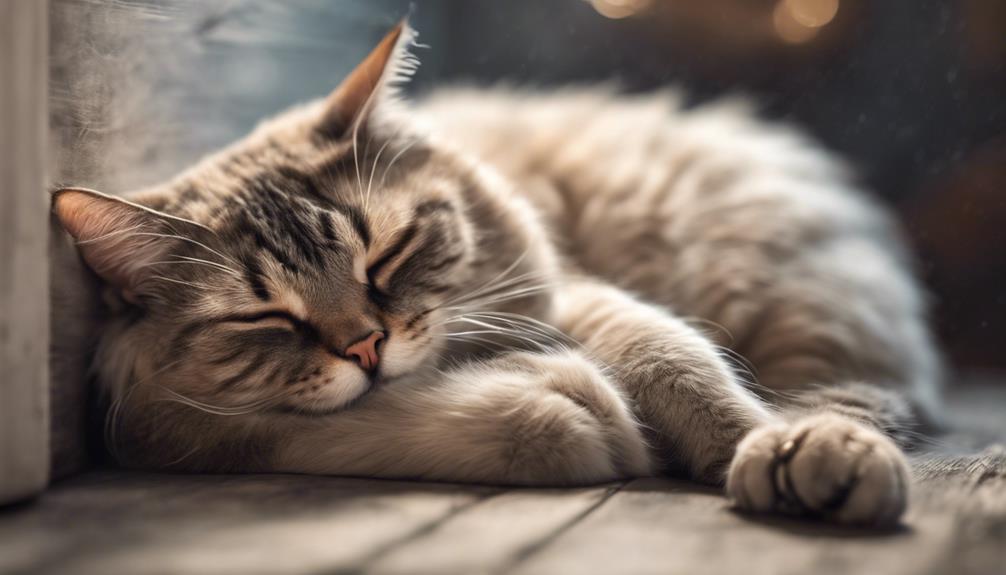
Cats often choose to curl up at their owner's feet to feel close and secure, seeking warmth and comfort in their proximity. It's a cozy spot for them to rest while still being near their beloved human. When a cat curls up at your feet, it's not just about finding a warm place to sleep; it's a gesture of trust and affection.
Here are some reasons why cats love to sleep curled up at their owner's feet:
- Close Bond: By sleeping at your feet, cats show their desire to be close to you, forming a strong bond of companionship.
- Sense of Security: Being near your feet provides cats with a sense of security, knowing that they're protected and safe.
- Warmth and Comfort: The warmth emanating from your feet creates a cozy and comfortable spot for your feline friend to relax and unwind.
Next time you find your cat curled up at your feet, know that it's their way of showing love, trust, and seeking warmth in your comforting presence.
Snuggling by the Side
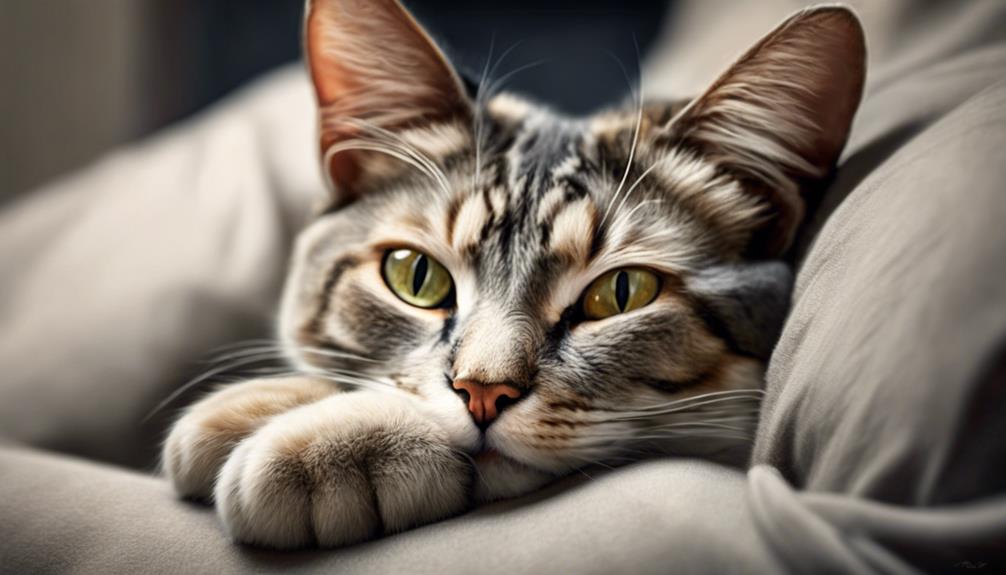
Snuggling by the side of their owner, cats seek warmth, comfort, and security in their soothing presence. This snuggle time is not just about staying warm; it signifies a deep bond built on trust and affection. When cats engage in side sprawl, they use firm presses to feel protected and desired closeness. This position allows them to feel the soothing presence of their owner's breathing and heartbeat, creating a sense of security. The strong bond displayed during this snuggle time speaks volumes about the cat's trust and affection for their human companion.
| Snuggling by the Side | |
|---|---|
| Benefits | Meaning |
| – Stay warm | – Trust and affection |
| – Feel protected | – Desire for closeness |
| – Soothing presence | – Strong bond |
| – Security | – Affectionate connection |
Frequently Asked Questions
What Is the Cat Sleeping Gesture?
We love when cats exhibit their affection through gestures like cuddling, purring, and seeking warmth near us. Observing these behaviors strengthens our bond, making us feel safe and loved. It's a special connection.
Why Do Cats Sleep in Cute Positions?
Cats sleep in cute positions near us to show trust and bond deeply. Their adorableness isn't just for show; it's a demonstration of the comfort and security they seek from our presence.
Where Your Cat Sleeps Near You and What It Means?
Where our cat sleeps near us and what it means: Our feline friend chooses to snuggle close for trust, warmth, and love. It signifies a bond, a sense of security, and a desire for companionship. It warms our hearts.
Why Do Cats Sleep so Cutely?
We sleep cutely near our owners to feel safe, secure, and connected. Being close helps regulate body temperature and reduces stress. It promotes comfort and strengthens our bond. Our adorable positions are signs of trust and affection.
Conclusion
To sum up, it's heartwarming to see our feline friends snuggled up in adorable positions near their owners. Whether they're cozying up on our laps, curling up at our feet, or snuggling by our side, their love and affection shine through.
These moments of connection bring joy and comfort to both cats and humans alike. It's a special bond that warms the heart and fills the soul with happiness.
Enjoy these precious moments with your furry companions!
Paul’s love for animals knows no bounds. As a dedicated writer and animal lover, Paul brings a unique perspective to our team. His firsthand experiences with various animals enrich our content and provide valuable insights into their behavior and needs. Whether he’s sharing tips for pet care or shedding light on pressing conservation issues, Paul’s passion for animals shines through in everything he does.
Cats
Can Cats Eat Cooked Meat Safely?
Uncover the secrets of feeding your feline cooked meat safely, ensuring their health and happiness.

Absolutely, cats can safely eat cooked meat. It's a fantastic protein source, benefiting heart health and overall well-being. Remember, cook it thoroughly, skip seasonings, and introduce it gradually. Stick to lean options like beef, chicken, or turkey for a balanced diet. Always remove bones, keep it plain, and serve in moderation. Watch out for harmful additives and high-fat content. Proper storage is key, too. Safely store, refrigerate, and monitor your cat's intake. Cooked meat can be a healthy treat but consult your vet for personalized advice. Keep your furry friend safe and happy with carefully prepared meat!
Key Takeaways
- Offer lean, well-cooked meats like beef, chicken, and turkey in moderation.
- Avoid seasoned or marinated meat and ensure it is boneless.
- Monitor for allergies or sensitivities and consult a vet if needed.
- Store cooked meat properly in airtight containers and follow safe food handling practices.
- Cooked meat should supplement a balanced diet for cats, not be the main component.
Benefits of Cooked Meat for Cats
Cooked meat provides essential protein for the heart health and good vision of cats. As a source of protein, it plays a vital role in maintaining our overall well-being. When we enjoy cooked meat, we aren't just savoring its taste but also benefiting from the nutrients it offers. Our bodies thrive on the protein found in cooked meat, helping us stay strong and healthy. This nutrient is especially important for our heart health and vision, keeping us active and our eyes sharp.
Including cooked meat in our diet can offer a range of benefits. It helps us maintain a balanced diet, ensuring we receive the necessary nutrients for our health. Additionally, cooked meat supports our reproductive system, contributing to our overall well-being. By introducing cooked meat gradually and in its plain form, we can enjoy these benefits without any added risks. As a snack, cooked meat provides us with additional nutrients, making it a wholesome and delicious treat.
Properly Cooked Meat for Cats
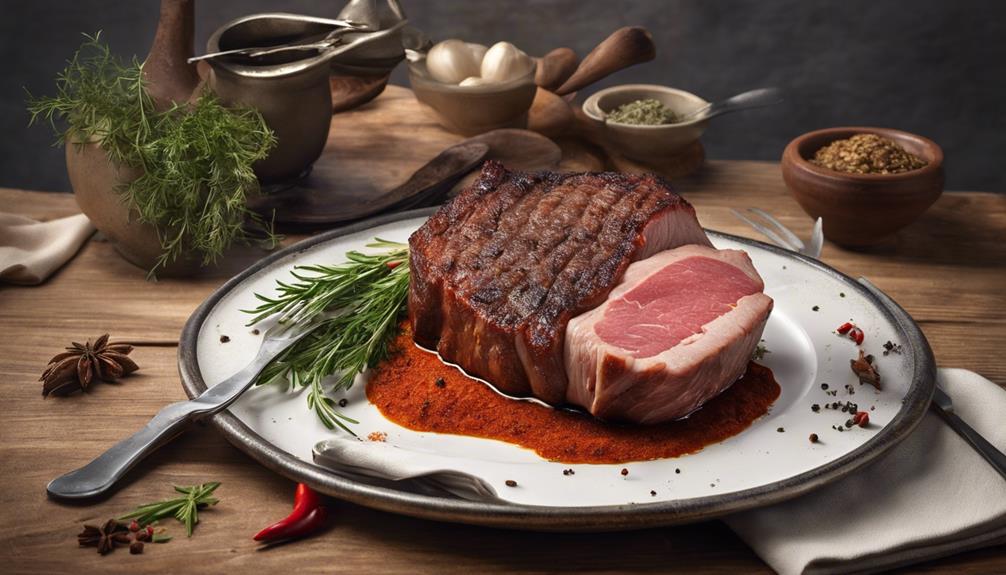
When preparing meat for your feline friend, make sure it's lean and bone-free to avoid any choking hazards. It's crucial to cook the meat thoroughly to eliminate any harmful bacteria that could potentially harm your cat. Here are some tips to guarantee you're providing properly cooked meat for your furry companion:
- Thoroughly Cooked: Guarantee the meat is cooked all the way through to safeguard your cat's health.
- Avoid Seasonings: Steer clear of seasoned or marinated meat, as some ingredients may be toxic to cats.
- Balanced Diet: Cooked meat should only be a small part of your cat's diet, alongside commercial pet food.
- Gradual Introduction: Introduce cooked meat gradually to monitor any adverse reactions or digestive issues.
- Safe Handling: Practice safe food handling procedures to prevent contamination and keep your cat healthy.
Potential Risks of Cooked Meat
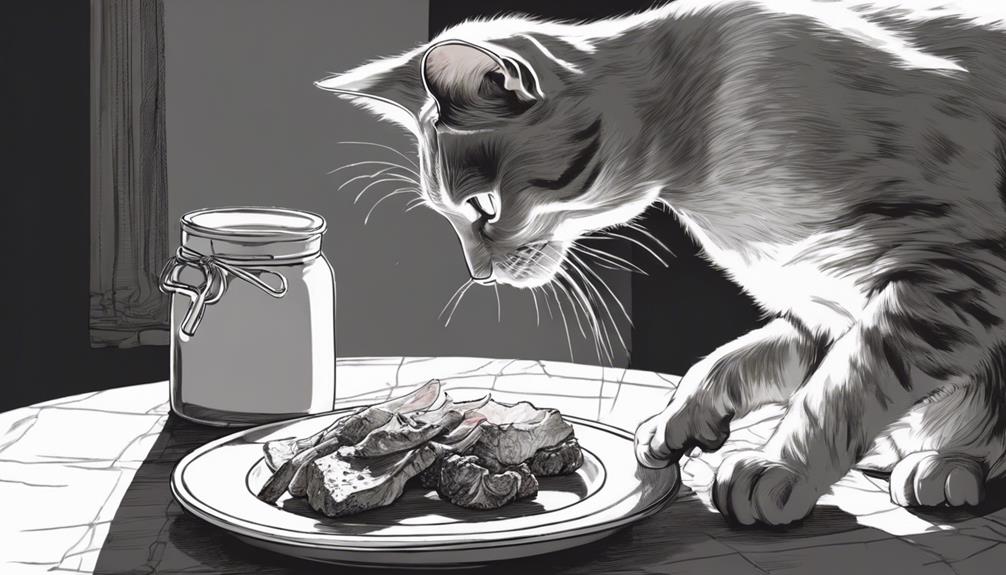
Regularly feeding cats cooked meat can pose various risks to their health and well-being. While cooked meat may seem like a tasty treat for your feline friend, it can actually lead to health issues. Cooked meat can be high in fat, potentially causing obesity and related health problems in cats.
Overconsumption of cooked meat may also result in digestive upset, such as vomiting or diarrhea. Additionally, cooked meat could contain seasonings or additives that are harmful to cats, posing risks of potential toxicity. Certain types of cooked meats, like bacon or sausage, are too high in salt and can be dangerous for cats to consume.
Being mindful of how cooked meat leftovers are stored is important, as improper storage can lead to bacterial growth and increase the risk of food poisoning in cats. Prioritizing your cat's health means being cautious about the cooked meat you offer them to safeguard their well-being.
Choosing Safe Meat Varieties
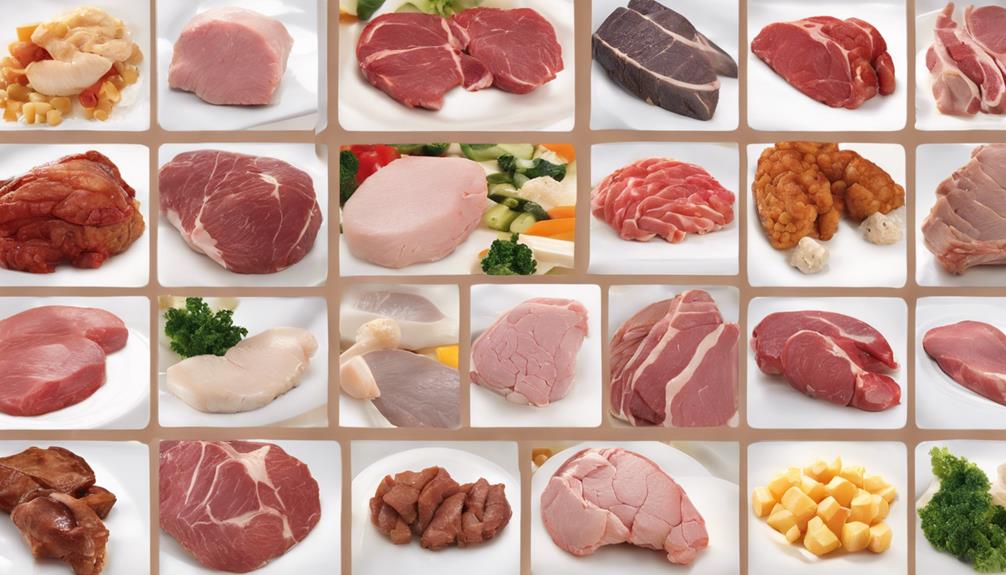
To guarantee the safety and health of your feline companion, opt for lean meats like cooked beef, chicken, turkey, and lamb when selecting meat varieties to feed your cat. Here are some tips to help you choose safe meat varieties for your furry friend:
- Choose lean meats: Select lean cuts of meat to provide your cat with essential proteins without excess fat.
- Ensure thorough cooking: Make certain the meat is cooked completely to eliminate any harmful bacteria that could be present.
- Avoid bones and skin: Remove bones and skin from the meat before feeding it to your cat to prevent choking hazards.
- Opt for high-quality meat: Pick high-quality, human-grade meat to guarantee your cat receives the necessary nutrients for a balanced diet.
- Feed in moderation: Remember that moderation is key when incorporating cooked meat into your cat's diet to maintain a healthy balance.
Cooking Methods for Cat Meat

For preparing cat meat, it's important to utilize cooking methods that maintain the meat's safety and nutritional value. When cooking meat for your feline friend, it's essential to avoid using spices, garlic, onions, and excess fat. These ingredients can be harmful to cats.
Make sure the meat is cooked thoroughly to eliminate any harmful bacteria that could make your cat sick. Remove all bones from the cooked meat before offering it to your cat, as bones can pose a choking hazard or cause internal injuries.
Keep the meat plain and free from any sauces or seasonings that may be toxic to cats. Cooking meat separately for your cat ensures that it's safe and suitable for their consumption. By following these guidelines and cooking methods, you can provide your cat with a tasty and safe meal that meets their dietary needs.
Seasoning Concerns for Cat Meat

When considering the preparation of cat meat, it's important to be cautious with seasonings, as certain spices like garlic and onion can be harmful to feline health. Cats have more sensitive taste buds than humans, so strong seasonings may not be appealing to them. Here are some seasoning concerns to keep in mind when cooking for your feline friend:
- Toxicity Risk: Seasonings like garlic and onion can be toxic to cats if consumed in large quantities.
- Dehydration Concerns: Excessive salt in seasoned meat can lead to dehydration and kidney issues in cats.
- Digestive Sensitivity: Cats may not tolerate spicy seasonings well and could experience gastrointestinal upset.
- Preference for Plain: It's best to offer plain, unseasoned cooked meat to cats to avoid potential health risks.
- Health First: Prioritize your cat's health by avoiding using seasonings that could be harmful to them.
Optimal Meat Portion Sizes

When it comes to feeding our feline friends cooked meat, it's essential to contemplate the best portion sizes. Cats typically enjoy around 1-2 tablespoons of cooked meat per meal.
Ensuring moderation in feeding cooked meat helps prevent any nutritional imbalances that may arise.
Safe Meat Portions
What amount of cooked meat should be included in a cat's meal to ensure safe and balanced nutrition? When considering the right quantity of cooked meat to feed your pet, it's important to maintain a balance for their overall health and well-being. Here are some key points to keep in mind:
- Best portion size is around 1-2 tablespoons per meal, depending on your cat's size and dietary needs.
- Balance cooked meat with other necessary nutrients in your cat's diet to prevent deficiencies or excesses.
- Moderation is vital to avoid potential issues like obesity and health problems.
- Cats may enjoy various cooked meats such as chicken, turkey, and beef, as long as they're fully cooked and bone-free.
- Consult your veterinarian to determine the appropriate portion size of cooked meat tailored to your cat's specific health and dietary requirements.
Cats Meat Preferences
Cats generally prefer small portions of cooked lean meats such as beef, chicken, turkey, liver, and lamb as part of a balanced diet. Best meat portion sizes for cats should be boneless, properly cooked, and served in moderation to prevent health issues.
It's crucial to guarantee that the meat is fully cooked, without any skin or bones, and free from spices or seasonings when feeding your cat. Meats like beef, turkey, and chicken offer essential nutrients for your cat's health and should be introduced gradually into their diet.
Providing a variety of cooked meats can cater to your cat's preferences while ensuring they get the necessary protein and nutrients. Remember, moderation and variety are key when it comes to your cat's meat preferences.
Feeding Cooked Meat
For cats, incorporating cooked lean meats like beef, turkey, and chicken in small portions can enhance their balanced diet with essential nutrients. When feeding cooked meat to cats, it's important to follow these guidelines:
- Cats can safely eat cooked lean meats like beef, turkey, and chicken in moderation.
- Make sure the cooked meat is boneless, well-cooked, and free from seasonings or sauces.
- Cooked meat shouldn't be the main component of a cat's diet but can be a healthy snack or occasional treat.
- Moderation is key to prevent digestive issues or nutritional imbalances.
- Introduce cooked meat gradually to monitor for any adverse reactions or sensitivities.
Feeding Frequency of Cat Meat

When incorporating cooked meat into a cat's diet, it's important to think about the best feeding frequency. While cooked meat is safe for cats to consume, it's essential to remember that moderation is key in their diet.
We should view cooked meat as a special treat or supplement to their regular cat food, rather than the main component. Introducing new proteins gradually allows us to monitor any potential allergic reactions or digestive issues that may arise.
Remember to keep the cooked meat plain, free from sauces, seasonings, or excessive fats to guarantee it's safe for our feline friends. Although cooked meat provides essential nutrients, it should be balanced with other elements of a cat's diet to meet their overall nutritional needs.
Monitoring Cats Meat Intake
To maintain a balanced diet for your feline friend, it's essential to monitor the quantity of cooked meat they consume. Here are some tips for monitoring your cat's meat intake:
- Keep track of the amount of cooked meat you offer to prevent overfeeding and guarantee a well-rounded diet.
- Moderation is key when treating your cat with cooked meat to avoid nutritional imbalances and excessive calorie intake.
- Monitor your cat's weight and overall health when incorporating cooked meat into their diet to make sure they're thriving.
- Consult with your veterinarian to determine the appropriate portion size of cooked meat for your cat based on their individual needs.
- Watch for any signs of digestive issues or allergies when introducing cooked meat to your cat's diet, such as vomiting, diarrhea, or skin reactions. It's important to be attentive to any adverse reactions to keep your cat healthy and happy.
Cat Meat Allergies

Watching your cat's meat intake is vital for maintaining their well-being, and it becomes even more important when considering potential cat meat allergies. While cat meat allergies are relatively rare, it's essential to be aware of the possibility.
Some cats may develop allergies to certain types of meat, with symptoms ranging from skin rashes and itching to vomiting and diarrhea. Common food allergens for cats include beef, dairy, fish, and chicken. If you notice any signs of a meat allergy in your cat, such as unusual behavior or digestive issues, it's advisable to consult a veterinarian for a proper diagnosis and treatment plan.
Veterinarians may recommend elimination diets to pinpoint the specific meat causing the allergic reaction in your cat. Remember, just like humans, cats can develop allergies to specific foods, so being vigilant and observant of your cat's reactions to different meats is key to ensuring their health and well-being.
Consulting a Veterinarian About Cat Meat

Seeking guidance from a veterinarian is essential when considering incorporating cooked meat into your cat's diet. Veterinarians play a critical role in ensuring your feline friend's health and well-being, especially when it comes to dietary choices. Here are some reasons why consulting a veterinarian is crucial:
- Veterinarians can provide personalized advice on feeding cats cooked meat safely.
- Consulting a vet ensures that the cooked meat meets your cat's specific dietary needs.
- Vets can recommend appropriate portions of cooked meat for your cat's size and health.
- They can advise on any potential allergies or sensitivities your cat may have to certain meats.
- Vets can guide you on how to introduce cooked meat into your cat's diet gradually and monitor their response.
Incorporating Meat Into Cats Diet
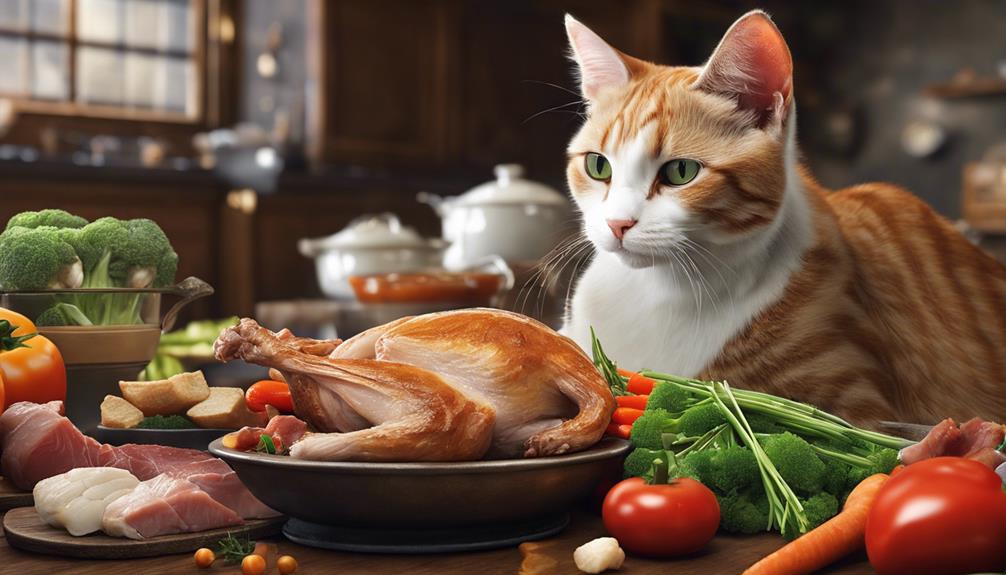
When it comes to incorporating meat into our cats' diet, it's important to prioritize their health by providing essential proteins and nutrients. By offering a variety of cooked meats like beef, turkey, and chicken, we can help fulfill our feline friends' dietary needs.
Ensuring that we remove bones, skin, and excess fat from cooked meat before serving helps prevent any potential choking hazards or digestive problems.
Meat for Cat Health
Incorporating a variety of cooked meats into a cat's diet is crucial for their overall health and well-being. Cooked meat provides essential protein that supports heart health and good vision in cats. When feeding your feline friend, consider cooked beef, chicken, turkey, and lean deli meats for their meat-based diet.
Remember to steer clear of raw or spoiled meat, as it can lead to illness. Introducing meat into your cat's diet can also contribute to maintaining a healthy reproductive system. To guarantee your cat's well-being, gradually introduce new proteins and avoid fatty cooked meats.
Your cat's health is a priority, so make informed choices when selecting their diet.
Protein Needs Met
To ensure peak health for our feline companions, it's essential to understand how including meat in their diet meets their protein requirements. Cats need protein for heart health, good vision, and a healthy reproductive system. Meat, such as cooked beef, chicken, turkey, and lean deli meats, serves as an excellent source of protein for our furry friends.
Not only does meat provide the essential proteins that cats need, but it also acts as a source of vitamins necessary for their overall well-being. It's important to introduce new proteins gradually into their diet to prevent any digestive issues.
While meat shouldn't be the sole component of their diet, incorporating it can be a beneficial addition to their complete and balanced cat food.
Cooking Methods for Safety
For ideal feline health, making sure the complete cooking of meat before feeding it to cats is essential. When incorporating cooked meat into a cat's diet, it's important to cook it thoroughly to eliminate any harmful bacteria that could pose a risk to your furry friend's health.
Here are some practical tips to guarantee the safety of cooked meat for your cat:
- Avoid using seasonings or sauces to prevent digestive issues.
- Remove any bones from cooked meat to prevent choking hazards.
- Introduce cooked meat gradually to monitor for potential allergic reactions.
- Remember that cooked meat should only be a small part of your cat's balanced diet.
- Always prioritize your cat's health by confirming the meat is fully cooked before serving it to them.
Rotating Meat With Other Foods
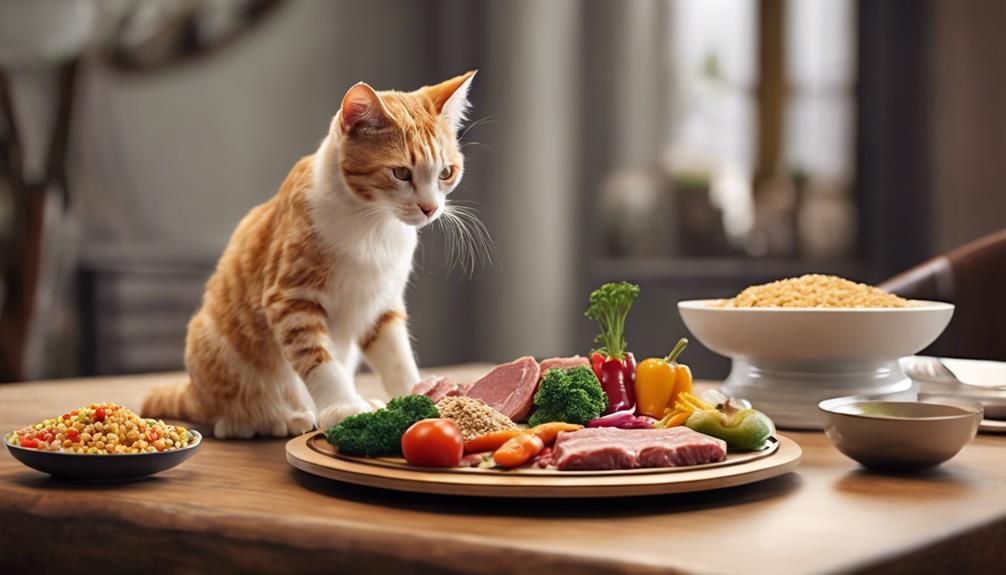
Rotating different meats with other foods guarantees a balanced diet for cats by diversifying their nutrient intake. By offering a mix of raw foods like meats alongside other cat-friendly ingredients, we can make sure our feline friends receive a well-rounded diet. Variety in a cat's diet is key to preventing nutrient deficiencies that may arise from sticking to just one type of meat. Catering to their taste preferences and nutritional needs through a diverse range of proteins can keep mealtime interesting and beneficial for our cats.
Moreover, rotating meats can also help prevent our cats from developing allergies or sensitivities to a specific type of meat over time. Including a variety of meats in their diet can significantly enhance their overall health and well-being by providing essential nutrients they need to thrive. So, next time you prepare your cat's meal, consider mixing it up with different meats and foods to keep their diet exciting and nutritionally robust.
Cat Meat Storage Guidelines
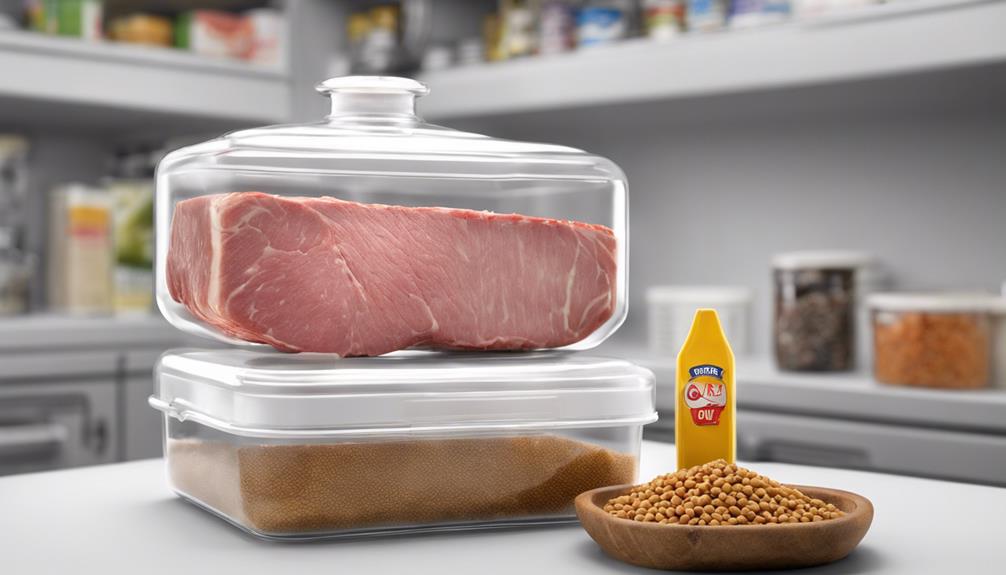
When storing cooked meat for cats, it's important to keep it in airtight containers in the fridge for 3-4 days or freeze it in freezer-safe bags for 2-3 months. Labeling containers with the cooking date helps track freshness, and thawing frozen meat in the fridge or microwave before feeding cats is essential.
Remember to discard any meat left out at room temperature for over 2 hours to prevent bacterial growth and guarantee your feline friend's safety.
Proper Meat Temperature
To guarantee the safety and freshness of cooked meat for cats, it's essential to store it at or below 40°F (4°C) in the refrigerator for up to 3-4 days. Ensuring proper meat temperature is vital for your feline friend's health. Here are some key points to remember:
- Store cooked meat at or below 40°F (4°C) in the refrigerator.
- Use a thermometer to check the temperature regularly.
- If freezing meat, make sure it's stored at 0°F (-18°C) or below.
- Thaw frozen meat in the refrigerator or microwave, not at room temperature.
- Proper storage and handling help maintain the quality and safety of the food for your beloved cat.
Refrigeration Best Practices
For best freshness and safety of cooked meat for cats, storing it in airtight containers in the refrigerator is vital. Keeping the cooked meat chilled helps maintain its quality and prevents harmful bacteria from multiplying.
Remember, leftover cooked meat should be consumed within 3-4 days to make certain it's safe for your feline friend to eat. To avoid any potential cross-contamination and foodborne illnesses, store the cooked meat away from other foods in the refrigerator.
Don't forget to label the containers with the storage date, making it easier to track freshness and making sure you don't feed expired meat to your cat. Proper refrigeration of cooked meat is essential to prevent spoilage and maintain its nutritional value for your beloved pet.
Avoid Cross-Contamination
To maintain the safety and freshness of cooked meat for your cat, storing it in airtight containers in the refrigerator is crucial in preventing cross-contamination. When dealing with human foods, make sure to follow these guidelines:
- Keep raw meat separate from cooked meat to avoid bacterial contamination.
- Use separate cutting boards and utensils for preparing raw and cooked meat for your cat.
- Wash your hands thoroughly after handling raw meat before touching cooked meat for your cat.
- Discard any cooked meat that has been left out at room temperature for more than 2 hours to prevent spoilage.
Following these simple steps will help guarantee that your cat's meals aren't only delicious but also safe to eat.
Conclusion: Cooked Meat and Cat Health
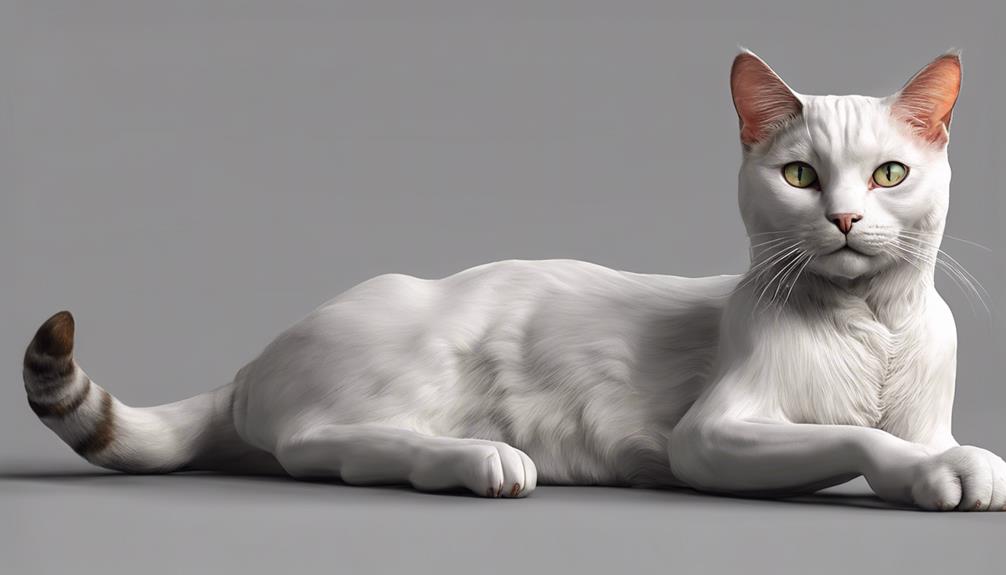
When considering the impact of cooked meat on cat health, it becomes apparent that this protein source plays a significant role in maintaining their overall well-being.
Cooked meat provides essential nutrition, especially protein, which is important for various aspects of a cat's health. From supporting heart health to ensuring good vision and a healthy reproductive system, protein from cooked meat is beneficial.
However, it's important to remember that cooked meat shouldn't be the main source of nutrition for cats. While it can serve as a healthy snack or supplement to their diet, a balanced and tailored meal plan is essential for their overall well-being.
Frequently Asked Questions
What Is the Best Meat to Cook for Cats?
When considering the best meat for cats, opt for lean options like beef, chicken, or turkey for their high protein content. These choices are nutritious and help maintain our feline friends' health and well-being.
What Cooked Food Can I Feed My Cat?
We can feed our cats a variety of cooked foods like lean meats, fish, whole grains, and eggs. It's crucial to make sure all bones are removed and avoid raw meats and fish to keep our feline friends safe and healthy.
What Human Foods Are Safe for Cats?
Oh, let's dig into what human foods are safe for our feline friends! Cooked meats like beef, turkey, and chicken, de-boned fish, whole grains, and a sprinkle of cooked eggs can make purrfect treats.
Can Cats Eat Scrambled Eggs?
Absolutely, cats can enjoy scrambled eggs as a safe and nutritious treat. Make sure they are thoroughly cooked and free from seasonings like salt, onion, or garlic. Introduce them gradually to guarantee your cat tolerates them well.
Conclusion
To sum up, cooked meat can be a beneficial addition to a cat's diet when prepared properly. By following safe cooking methods and selecting appropriate meat varieties, you can provide your feline friend with a tasty and nutritious treat.
Remember to rotate meat with other foods to guarantee a balanced diet, and always store meat properly to maintain freshness and quality. Your cat's health and well-being will thank you for it!
Paul’s love for animals knows no bounds. As a dedicated writer and animal lover, Paul brings a unique perspective to our team. His firsthand experiences with various animals enrich our content and provide valuable insights into their behavior and needs. Whether he’s sharing tips for pet care or shedding light on pressing conservation issues, Paul’s passion for animals shines through in everything he does.
-

 Vetted1 month ago
Vetted1 month ago15 Best Cat Foods for Managing Hyperthyroidism – Vet Approved and Feline Friendly
-

 Cats7 months ago
Cats7 months agoTop 5 Cat Breeders in Arkansas: A Guide
-

 Animal Facts2 months ago
Animal Facts2 months agoSpring Animals: A Guide to Seasonal Wildlife
-

 Vetted1 month ago
Vetted1 month ago15 Best Fresh Dog Food Delivery Services for Your Pup's Health and Happiness
-

 Rabbits2 months ago
Rabbits2 months agoExploring Rabbit Holes: What Do They Look Like?
-

 Vetted1 month ago
Vetted1 month ago15 Best Dog Foods for Kidney Disease – Expert Recommendations for Your Pet's Health
-

 Pets2 months ago
Pets2 months agoLatest Pet Statistics in US – Trends & Insights in 2024
-

 Fish2 months ago
Fish2 months agoKeeping Your Sucker Fish Thriving at Home





















